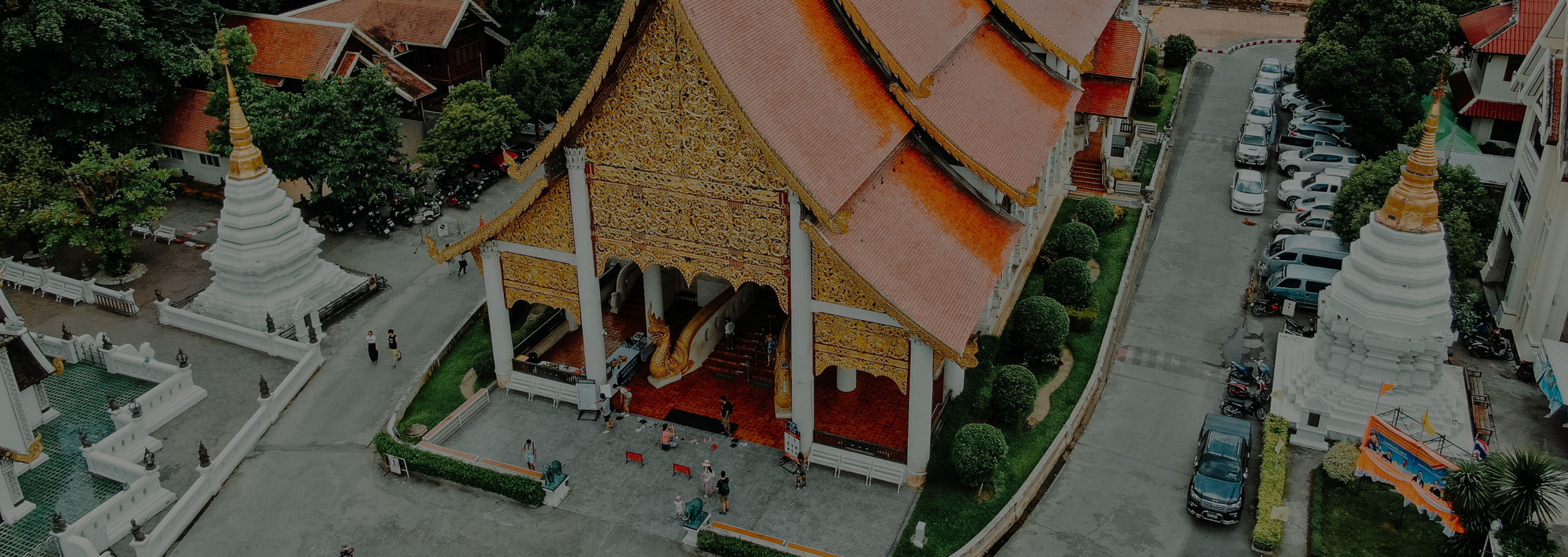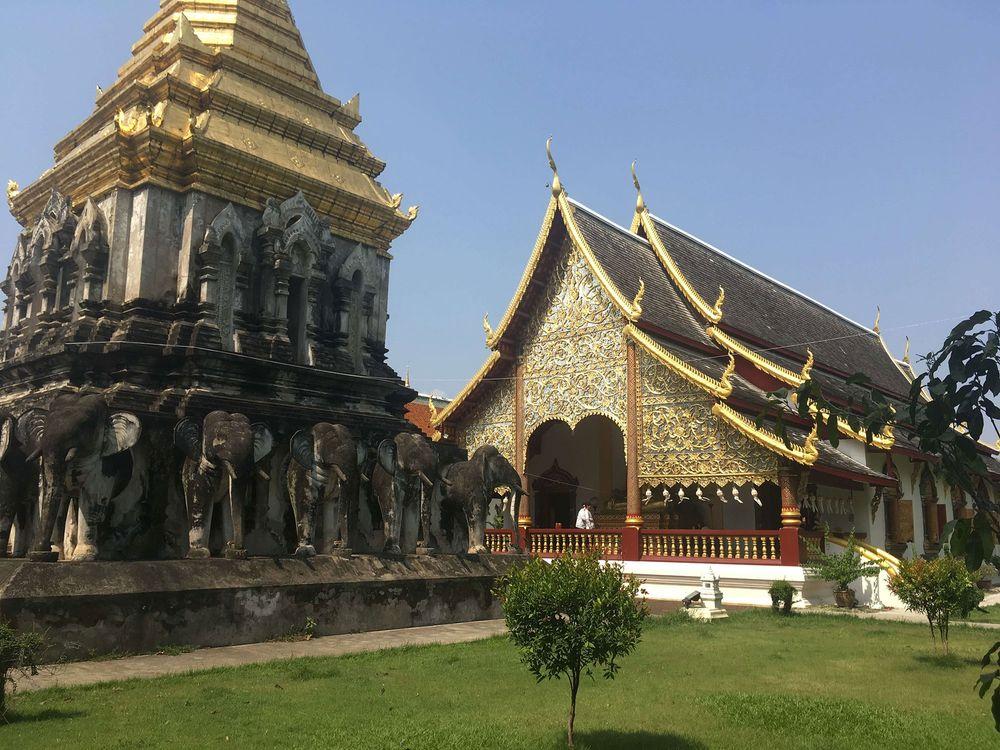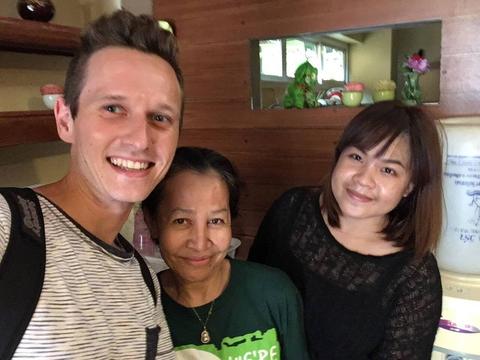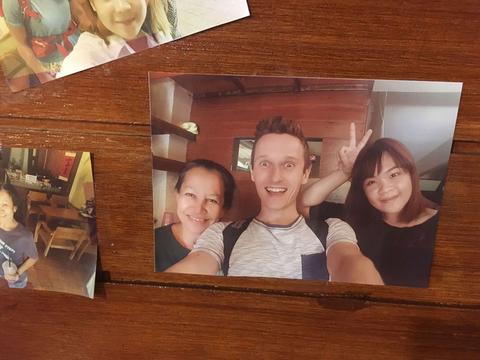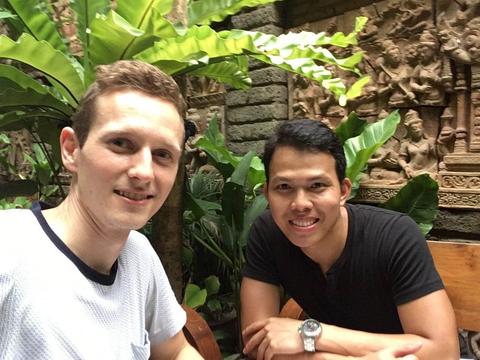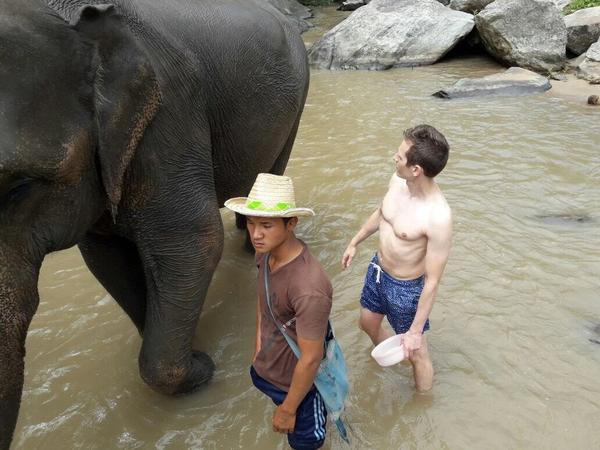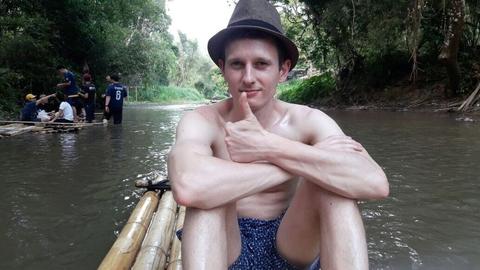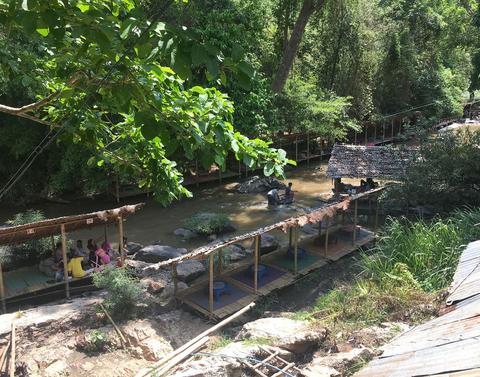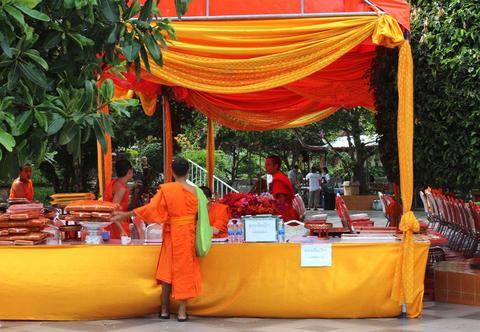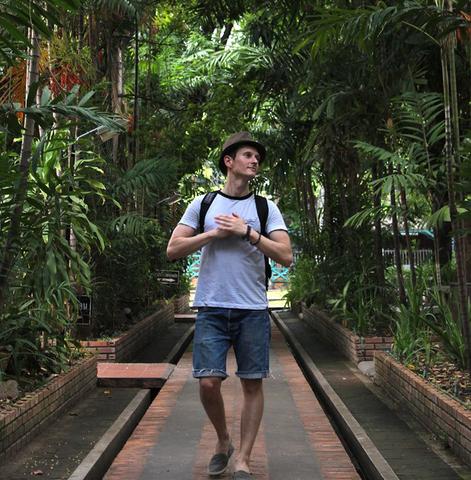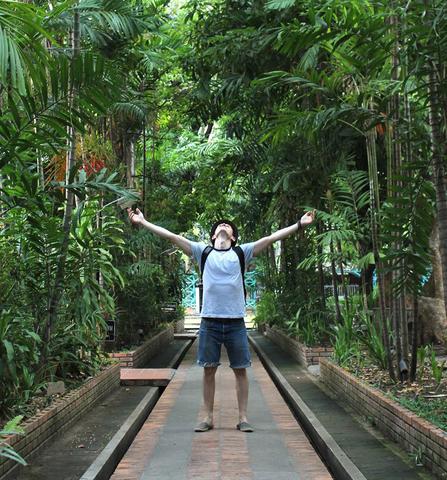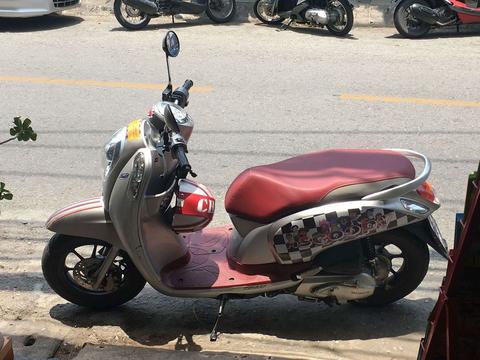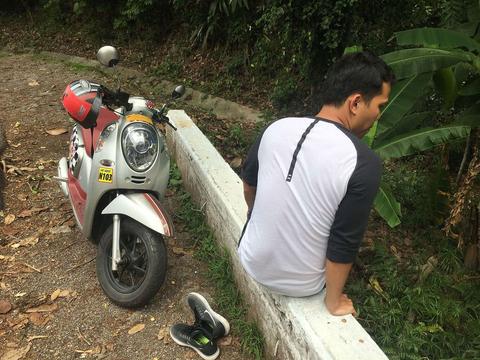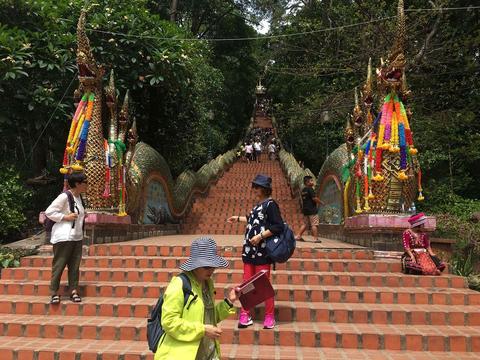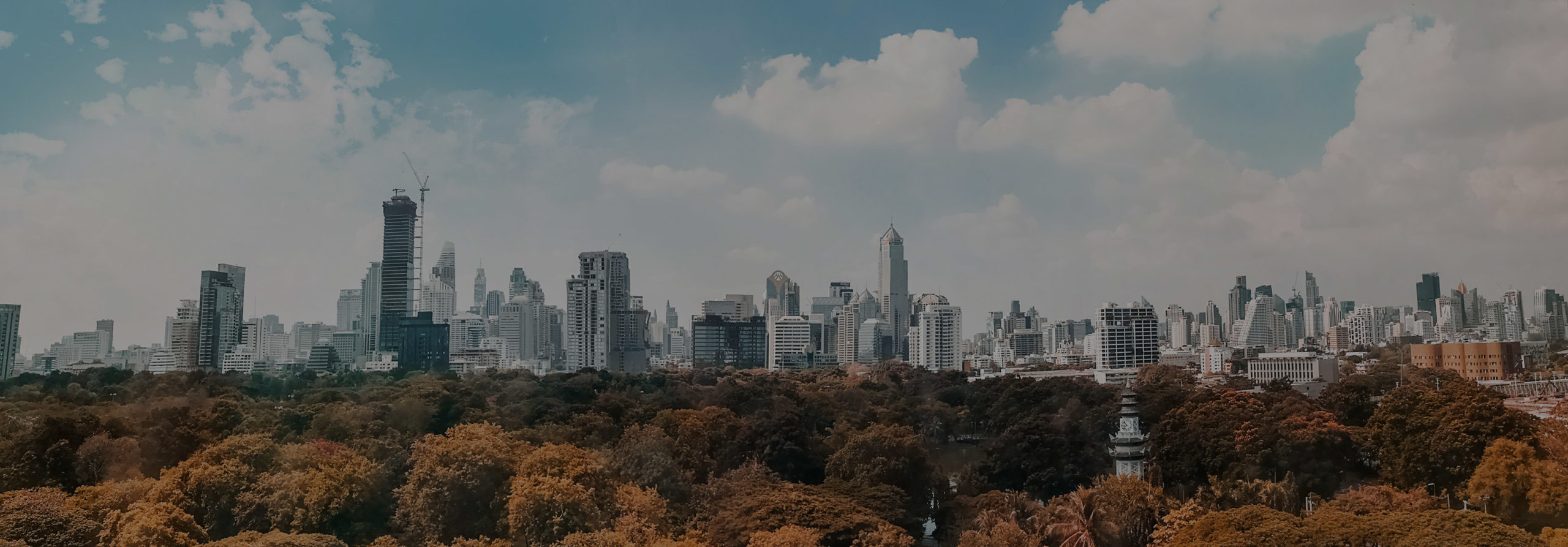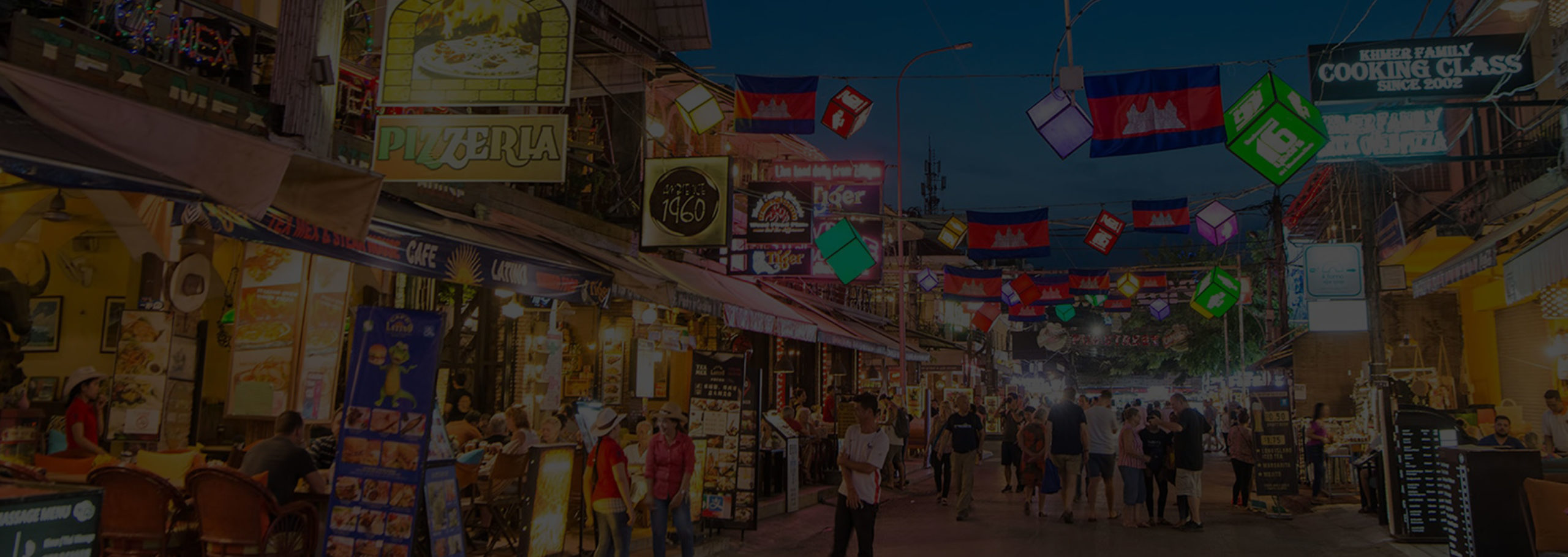
Sieam Reap
Siem Reap lies in northwestern Cambodia and is a popular resort town and a gateway to the Angkor region. Siem Reap today - being a popular tourist destination - has a large number of hotels, resorts, restaurants and businesses closely related to tourism. This is much owed to its proximity to the Angkor temples, the most popular tourist attraction in Cambodia.
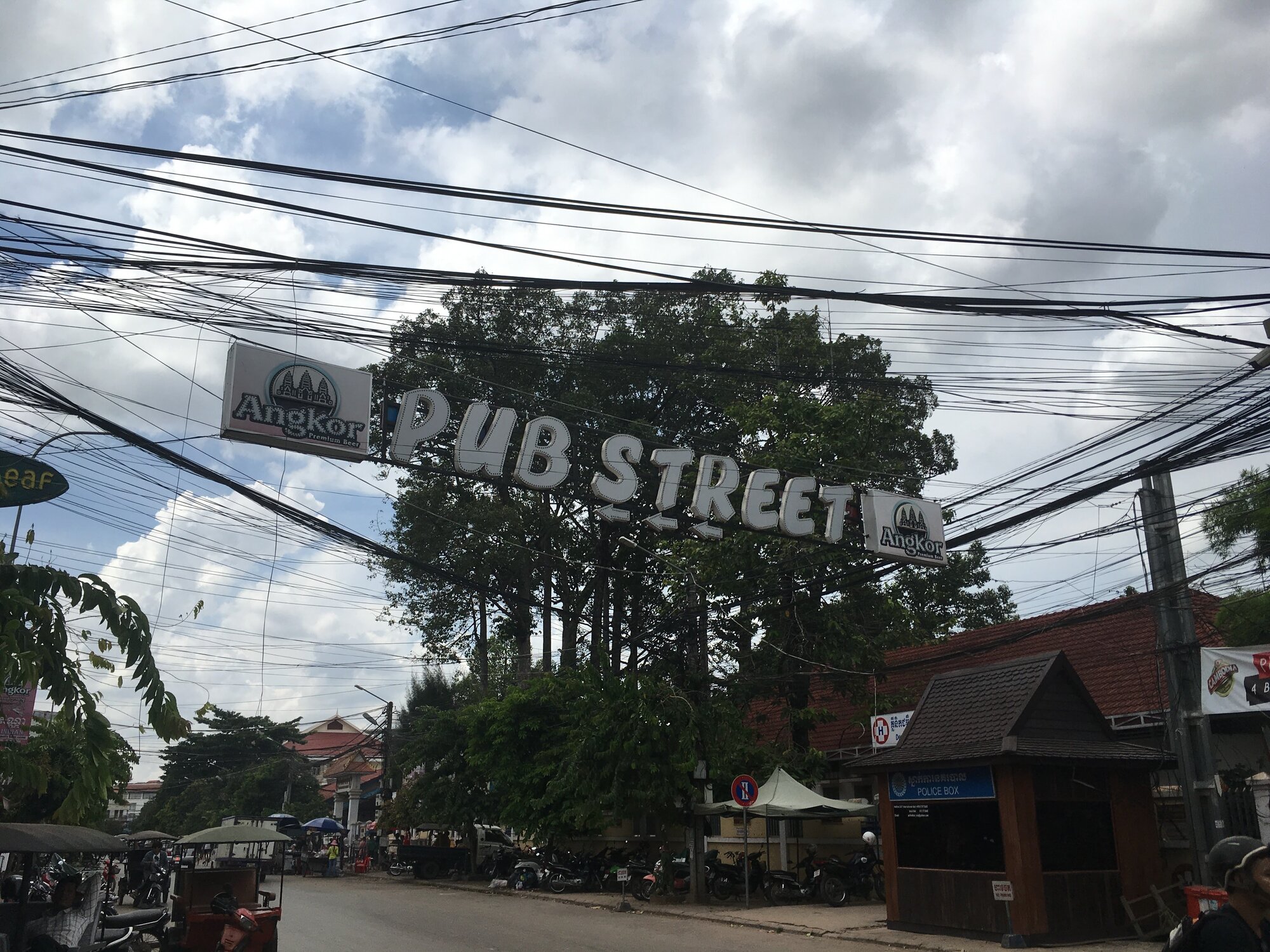 Pub Street - the central entertainment area in Siem Riep.
Pub Street - the central entertainment area in Siem Riep.
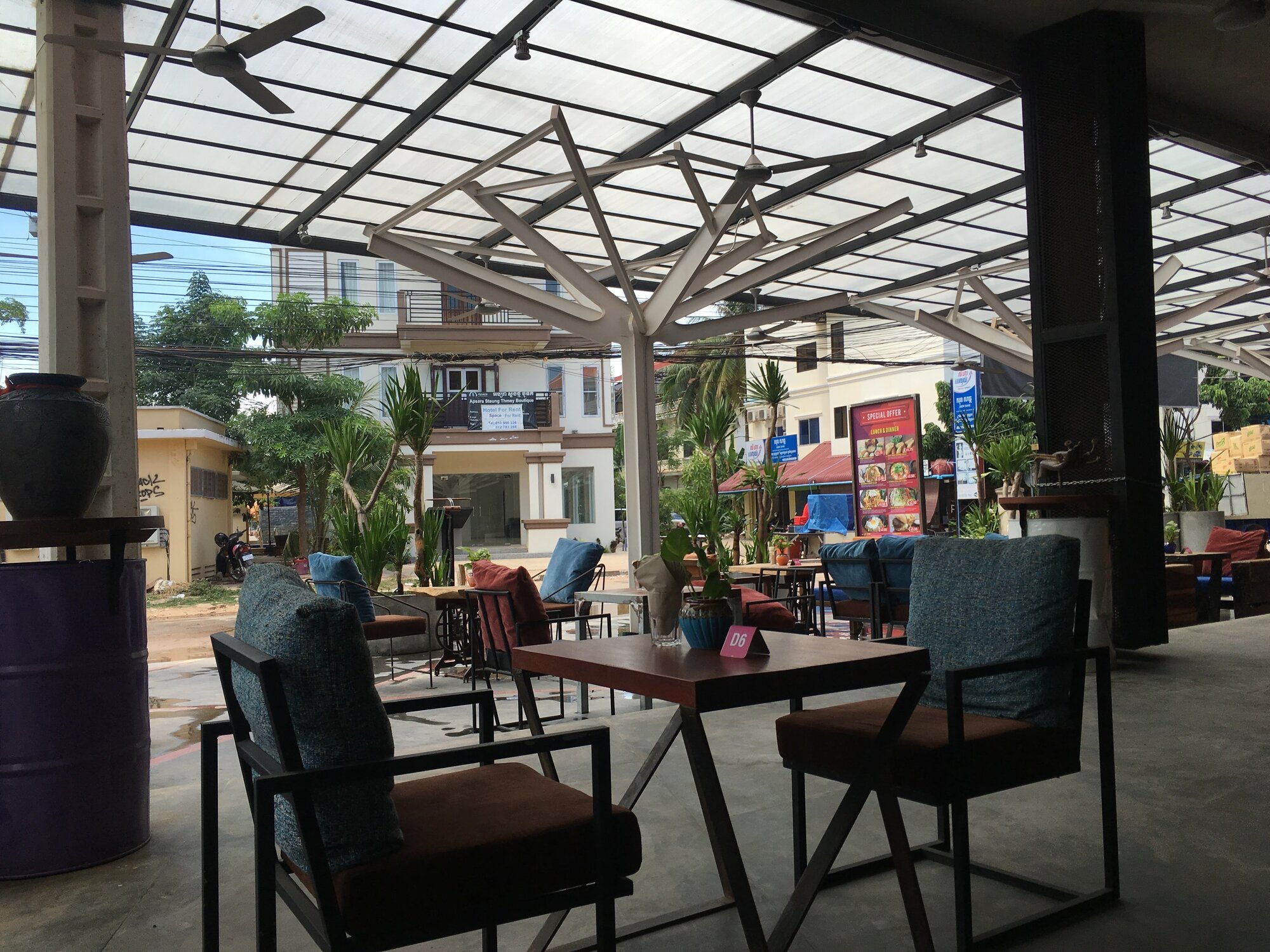
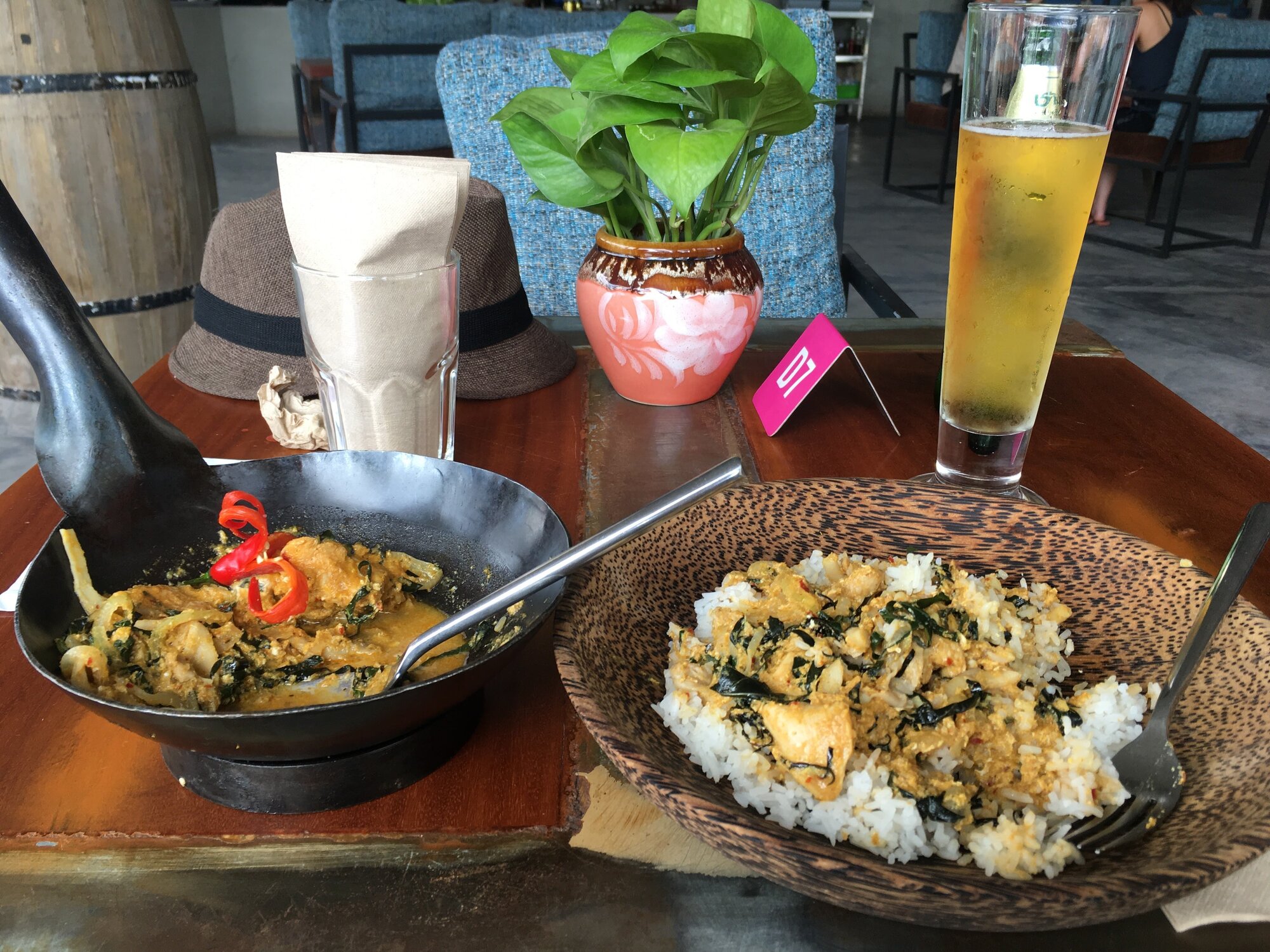 Having a delicious lunch at a local restaurant outdoors.
Having a delicious lunch at a local restaurant outdoors.
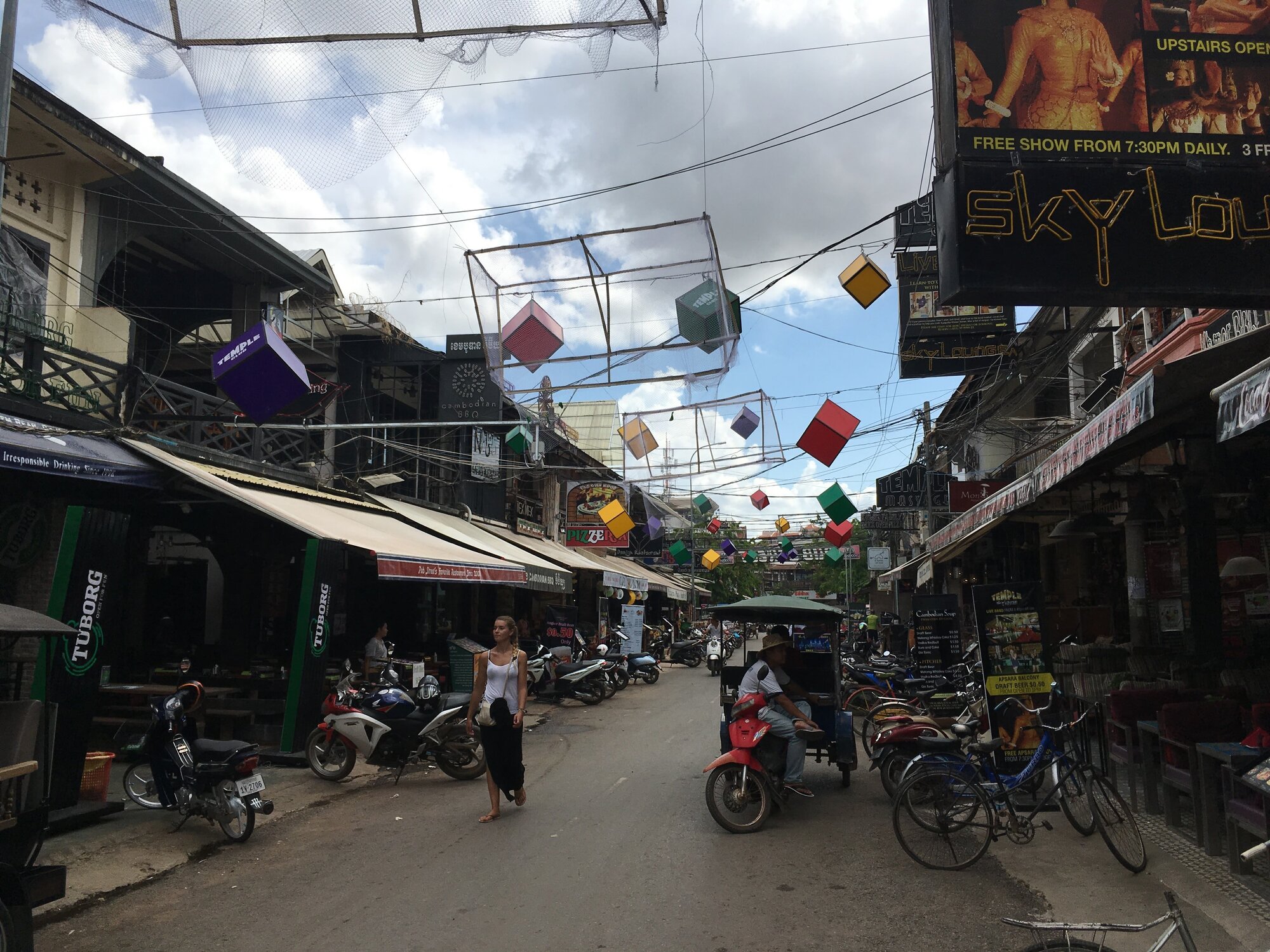 View of the Pub Street.
View of the Pub Street.
Getting to Cambodia
After coming back from Chiang Mai, I stayed one night at a friend’s place in Bangkok before going on a journey to Cambodia to visit the famous Angkor temples. I’ve known about the temples for a long time and also heard stories about Cambodia from a friend who’s already been there, so for me this would be a dream come true. My imagination was fired. The ruins of the temples lie close to the modern city of Siem Reap in the north-western part of Cambodia. The easiest way to get there is by plane, e.g. via the Air Asia airline. I decided to stay on land and take the train from Bangkok, something that retrospectively turned out to be an adventurous, but also more strenuous experience. I don’t regret doing it, but if I was to do it again, I would definitely take the flight.
The train from Bangkok goes to Aranya Prathet station which lies only 3.8 miles (6.1 kilometers) before the Cambodia-Thai border. It’s the end station on the Thai side and the rest of the journey needs to continue on the Cambodian roads. But the first challenge was to get to the border and cross it. Already while getting off the train on the tracks you are confronted by folks trying to get you on their (probably overpriced) tuk tuks, as the border is still a few miles away. With my big backpack I felt very exposed as a tourist, but I sticked to my rule of not accepting any services until I get out of the station and find the ‘legitimate’ tuk tuk spots from where to go. So that’s what I did. I passed the station in front of which many tuk tuk drivers were waiting for the passengers to take them to the border. I got on one very quickly and for 80 baht (which seemed a reasonable price to me) I was taken down the long main road to the checkpoints.
Once I got off, I still needed to pass a few hundred meters on foot through what seemed to be a huge market place. The only way was straight to the checkpoint, but the sides were lined up by many sale stalls and there was traffic everywhere. It was a crowded and noisy place and walking on your own as a westerner with a backpack felt a bit intimidating, especially because people might fight for your attention trying to sell you stuff or offer some visa services which you don’t need. You just move on and ignore the rest. Thank goodness I used Google Maps and researched the trip before, so I knew where to go.
Everything nearby the border looked like regular sale stalls, even the official buildings, so it was very easy to miss the actual visa office which was the place where I needed to obtain my visa before proceeding to the checkpoint. Once I got there, I got my visa for $30 and then carried on to the crossing. Even there it was confusing as the international tourists needed to walk up the stairs and inside the building to meet the officials. I didn’t realize that fist, so I stayed on the street and tried to go straight through until someone started to shout at me. First I ignored him, as I thought it’s just one of those misleading fraudsters. But as he was very persistent, I realised he was just trying to show me the right way. So I gladly followed, went up and inside the building to queue at the right spot where I could finally check out from Thailand and into Cambodia. Then, outside and after another few meters I stopped at a Cambodian desk (it just looked so provisional) and entered into the Cambodian territory. Another few meters and I passed under an archway made in the style of Angkor temples. Now I knew I really made it through. I was in Cambodia!
But my journey wasn’t over yet. I still needed to find the transport to get me another 3 hours to Siem Reap. As I researched the trip, I knew that after another few meters (yes, it was a lot of walking) there would be a roundel from which a bus was supposed to take passengers further on their journey. I was approached by a guy who kept talking to me, and I thought it was a fraudster, so I was ignoring him. Yet, once I reached the roundel and wondered whether there was a coach to take me further, the guy approached me again and pointed out the way. So again, it was a case of someone trying to help me, and in my distrust of fraudsters I needed a while to realise that is was legitimate. But hey... you need to stay alert and vigilant in such situations - better safe than sorry.
Two Polish girls went inside the coach, and as I speak Polish too, I felt more encouraged and relieved that I might have finally found the means of transport to take me directly to Siem Reap. I exchanged some words with the girls and felt much more safe. My loneliness was over for a time. The bus took us not far away to another local bus station where we waited again for a smaller shuttle bus which then took us on the Cambodian roads to our destination. With a small break in between at a local store where we could use the toilet in exchange for buying something (yes, they try to make money with you whenever they can), we continued through the flat landscape of Cambodian fields until we arrived in Siem Reap in late afternoon.
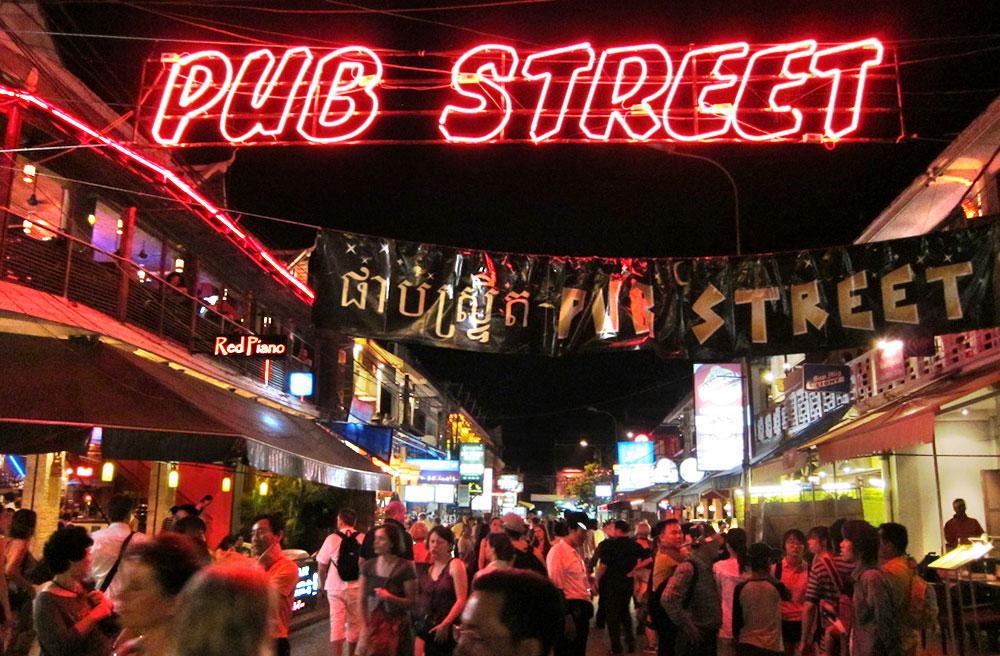
Pub Street in the centre of Siem Reap.
From a common point where we arrived they offered us a taxi ride to our hotels for extra money, which made sense to me, but some people wanted to be taken directly and not pay anything extra. So there were some initial discussions and haggling about how much to pay, as the drivers wanted more dollars than what we were willing to pay. I joined the Polish girls and the driver wanted, as far as I remember, 5 or 6 dollars from each of us which was totally expensive compared to what we read about the legitimate rates. We talked the price down a bit, and once we all agreed, we were taken to our places one by one. Finally, I arrived at my hotel in the center of Siem Reap and was absolutely relieved and happy that I made it. Retrospectively, it all became a fun and exciting memory, but if you just wanted to get from A to B, the whole trip on land was too much hassle to go through. On my way back to Bangkok I definitely took the flight, as the thought of going through all those different stages again was too overwhelming.
Riding the streets of Siem Reap.
Bats in Royal Independence Gardes in Siem Reap.
On the streets in Siem Reap towards Angkor Wat.

View of the swimming pool at my hotel. It was mostly empty of people.
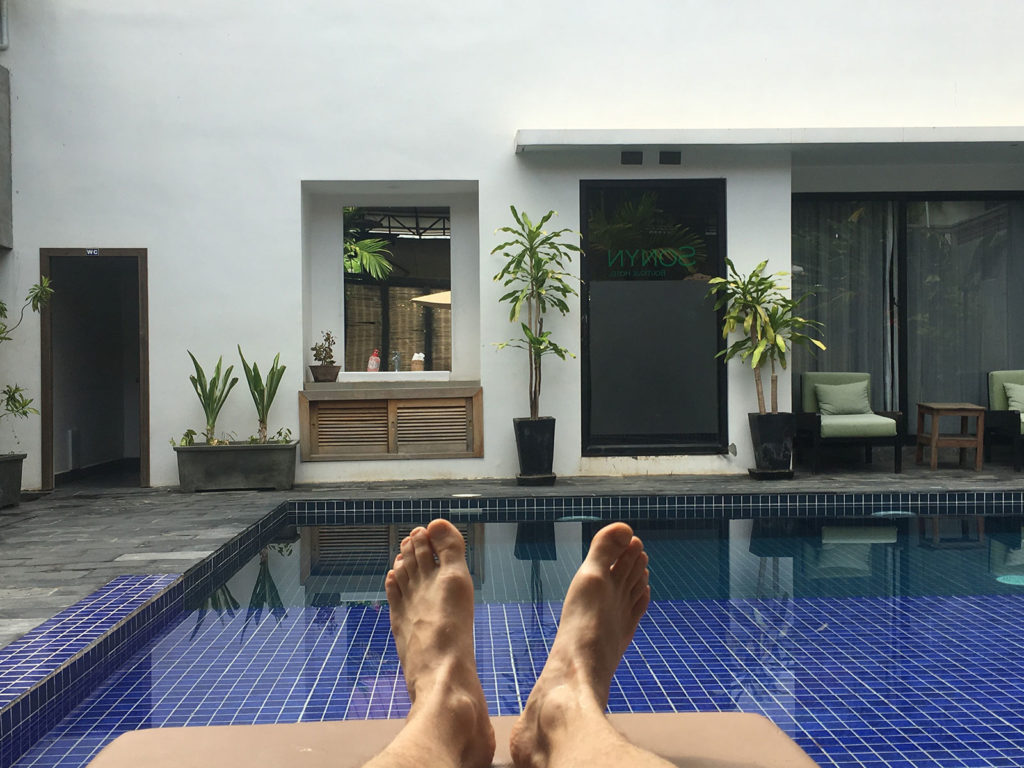
Hanging out with my feet out. It was hot!
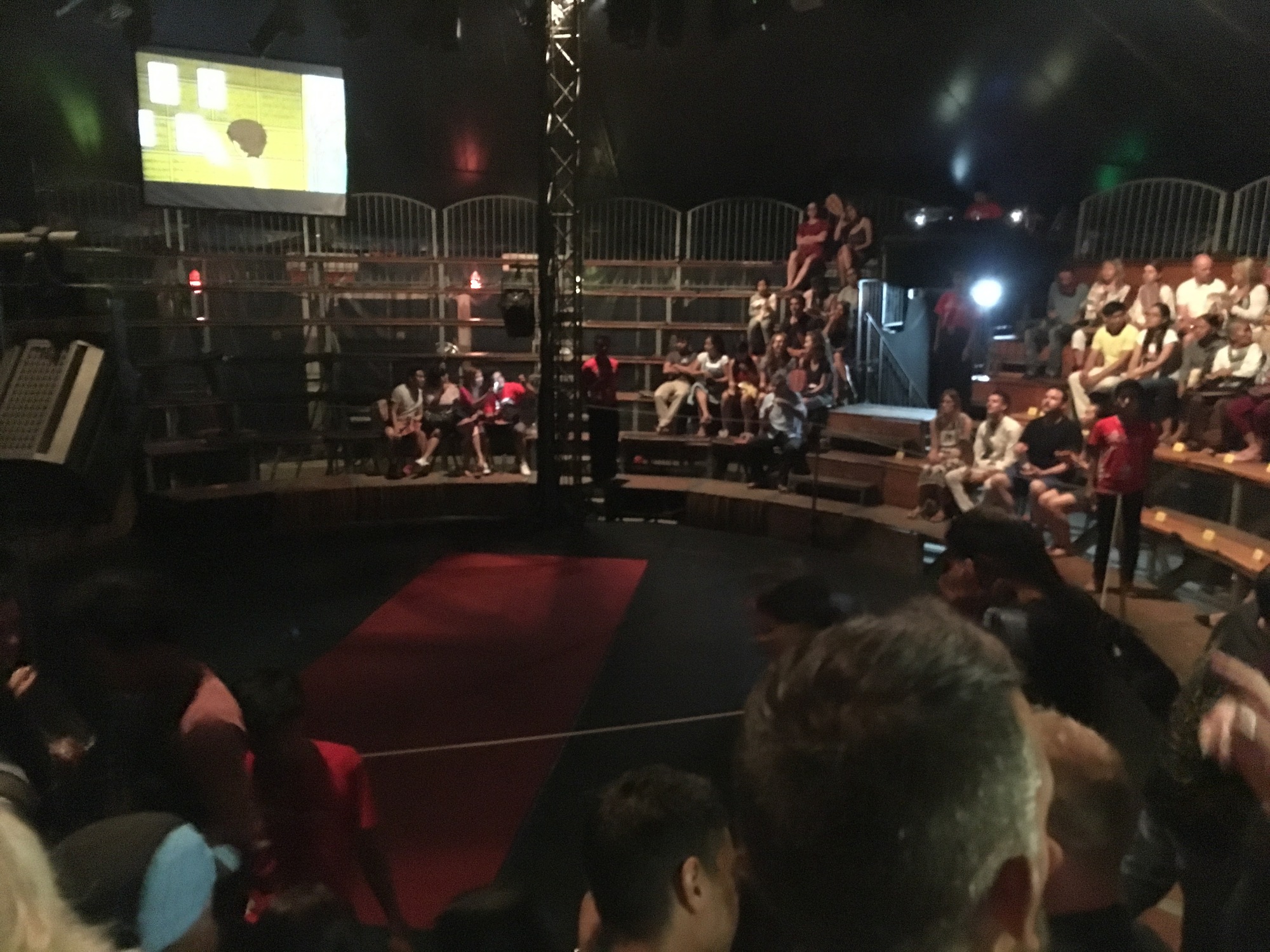 The Phare circus is slowly filling with viewers.
The Phare circus is slowly filling with viewers.
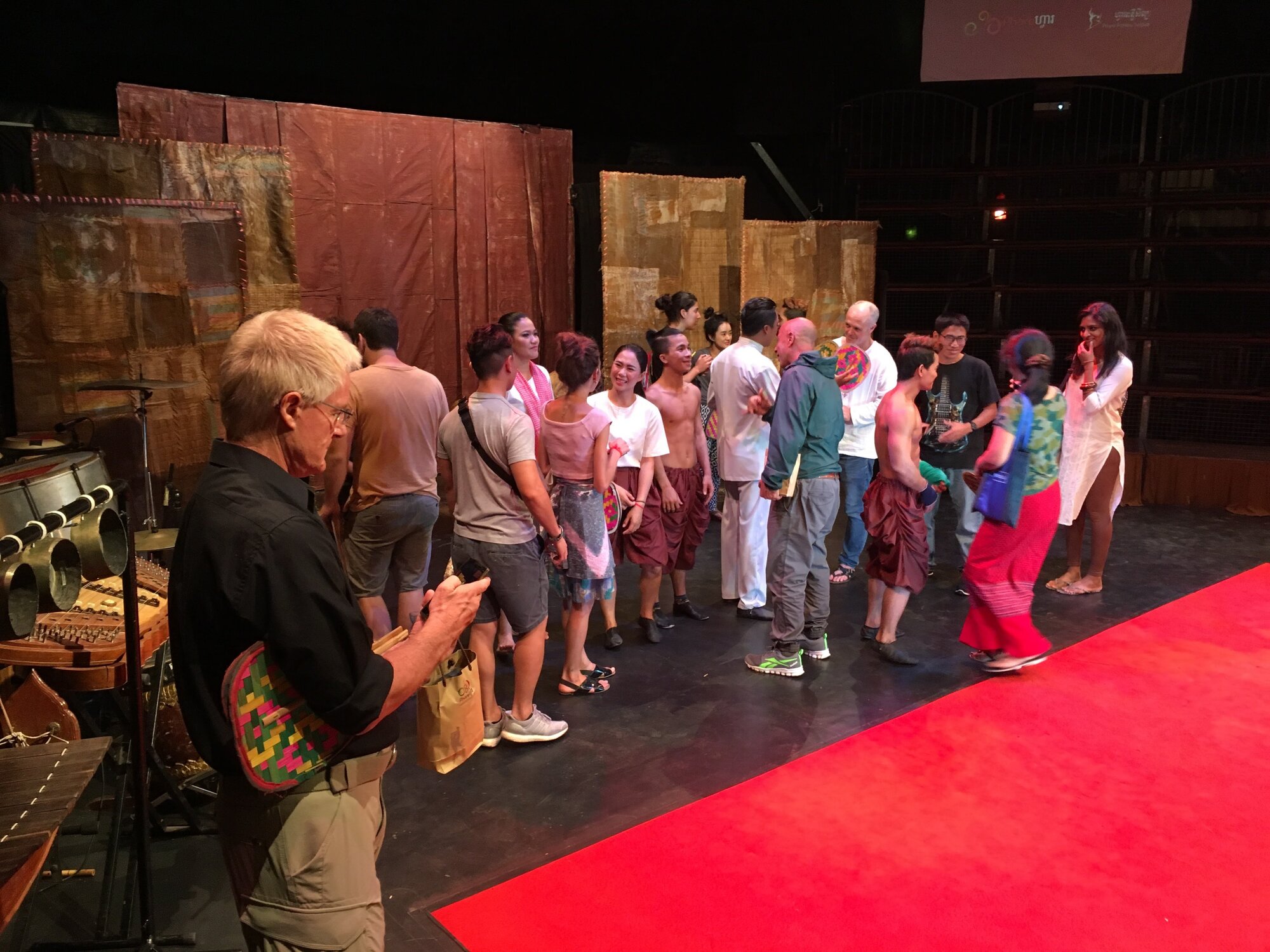 A relaxed hangout after the performance.
A relaxed hangout after the performance.
During the circus performance.
The end of the show.
Exploring Siem Reap
Siem Reap had a small town feeling, just like Chiang Mai in Thailand. In fact, I found those two cities very similar. I spent in Siem Reap 5 nights and was renting a bike on a regular basis to explore the city in a relaxed way. There was a traffic of motorbikes everywhere on the streets. Very quickly I noticed that everything was incredibly cheap. For dinner I usually spent around 3-4 dollars. Everywhere there were cool bars and restaurants and awesome places to hang out in the evenings or at night. I was on my own, but I imagine being with a group of friends could have made the experience in this town so much more fun.
I remember dining at the first small bar opposite my hotel. I stayed very central at De Sonyn Boutique hotel at Taphul Road. From there it took me only three streets further south to Pub street, the center of Siem Reap and the ultimate party mile of the town. Also not far away by the small Siem Reap river there was the Royal Independence Gardens, a bit of greenery in a city full of traffic. There I spotted vast numbers of bats hanging from the trees during the day. It was a weird, but very compelling and mesmerizing sight.

The back yard with the swimming pool at De Sonyn Boutique hotel.
Coming out of the park I crossed the river, turned straight left and rode for a while along the River Road north, and eventually arrived at The 1961 Coworking Space and Art Space. I wanted to do some work during my travels, so I regularly researched coworking spaces whenever I went. I found one such spot in Siem Reap and it was The 1961 Coworking Space. In a calm area away from the noise and business of the town I entered the place and was greeted by a lovely girl. The complex actually consisted of two buildings: the actual coworking space in form of a long room with desks, and a two-floor art space building right next to it. The space was empty for a reason I don’t remember any more, but for 5 dollars I could use the desks in the coworking space for the entire day. So I did. The girl also showed me around in the adjacent art space. We exchanged contact details and I left with a good feeling of having done something constructive and having made great new traveling acquaintance.
I took it easy on my very first day. The whole purpose was to visit the Angkor Wat ruins, but I didn’t want to rush there straight on the next day. So I took some time to settle down, eat and drink, explore the surroundings and gain some overall impression of the city life. Later during my stay I visited Phare, the Cambodian Circus which was located west of the city centre. It’s a locally famous youth circus show staged by young acrobats who train for many years to be able to perform. It’s a good thing as the circus allows many young people to escape poverty or have some new perspectives in life at such a young age in a country which is still only slowly developing and recovering from the horrors of its own past. I enjoyed the show a lot and had a really nice chat with a local man sitting next to me who gave me some background information about the performance, the youth and the country in general. I definitely recommend Phare, the Cambodian Circus.
On the third day I finally decided to visit the Angkor Wat ruins. The Big Day has arrived!
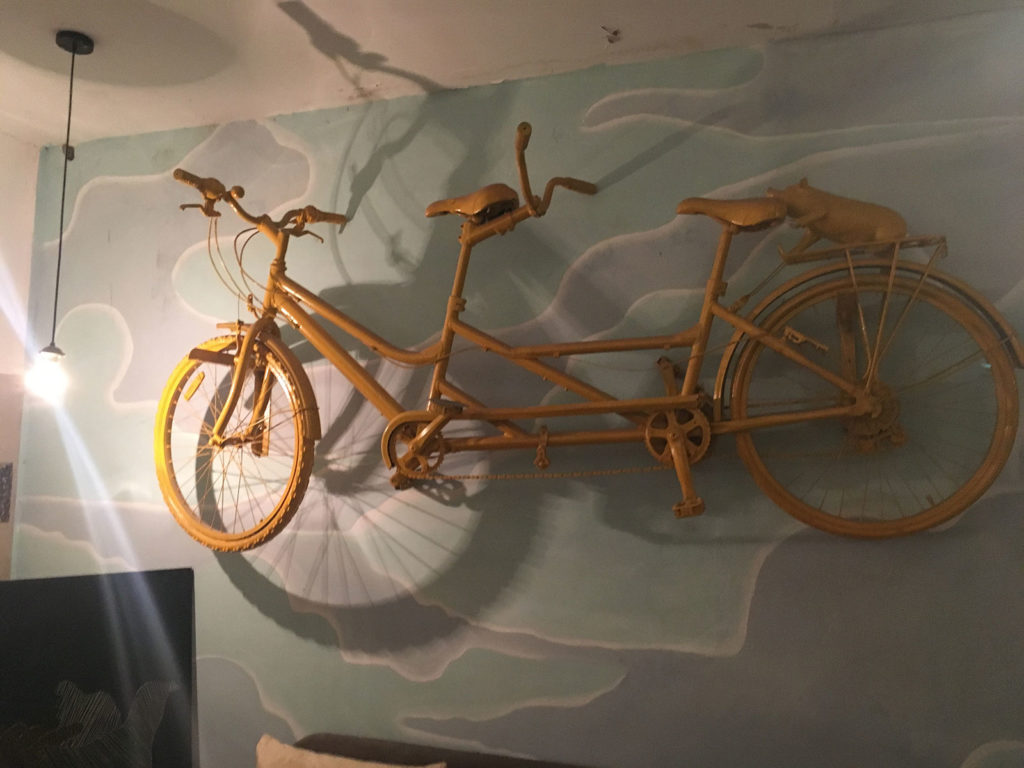
Some impressions of the 1961 Coworking Space in Siem Reap.
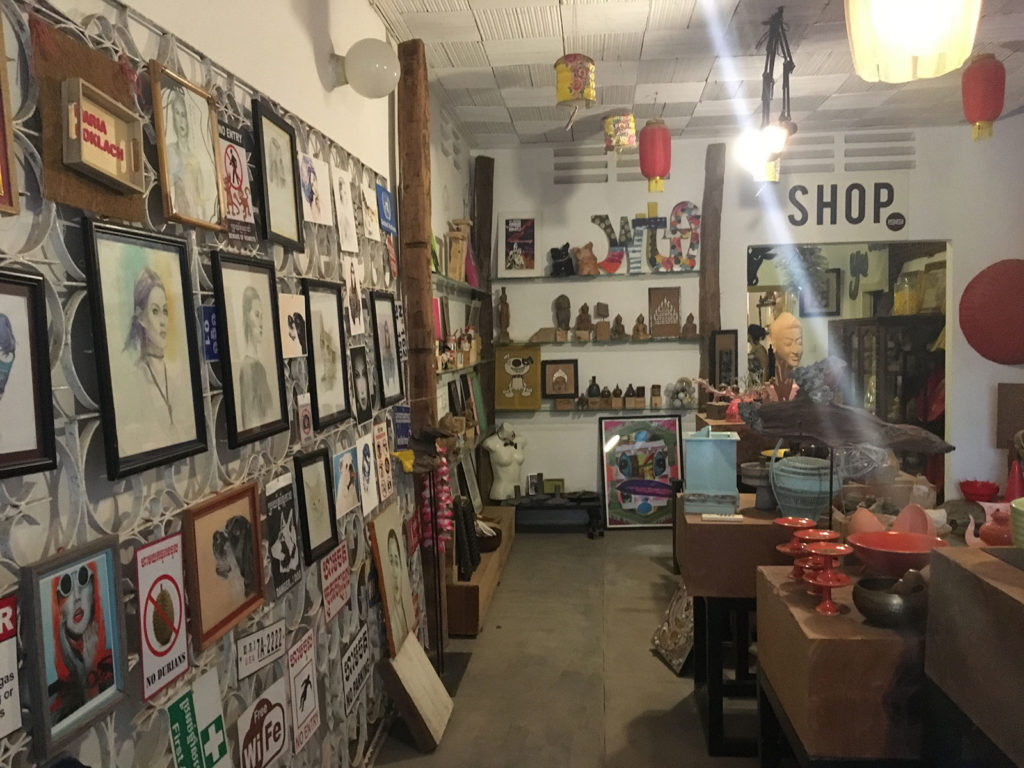
A gallery shop next to the co-working space.
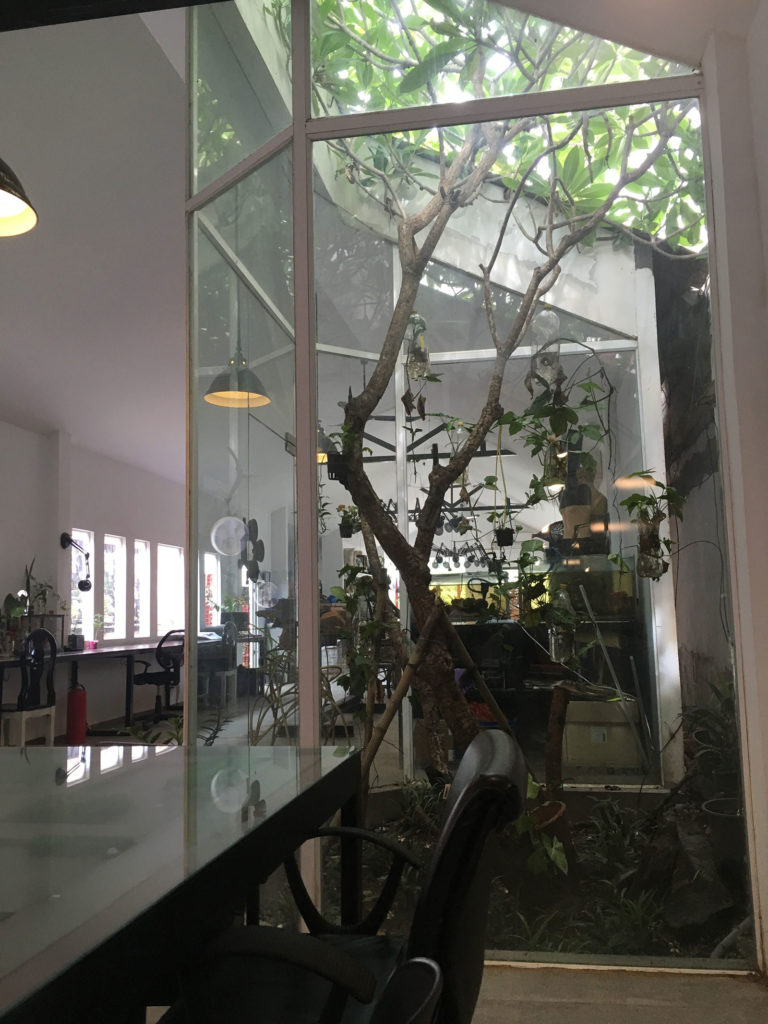
The view from my desk at the co-working space.
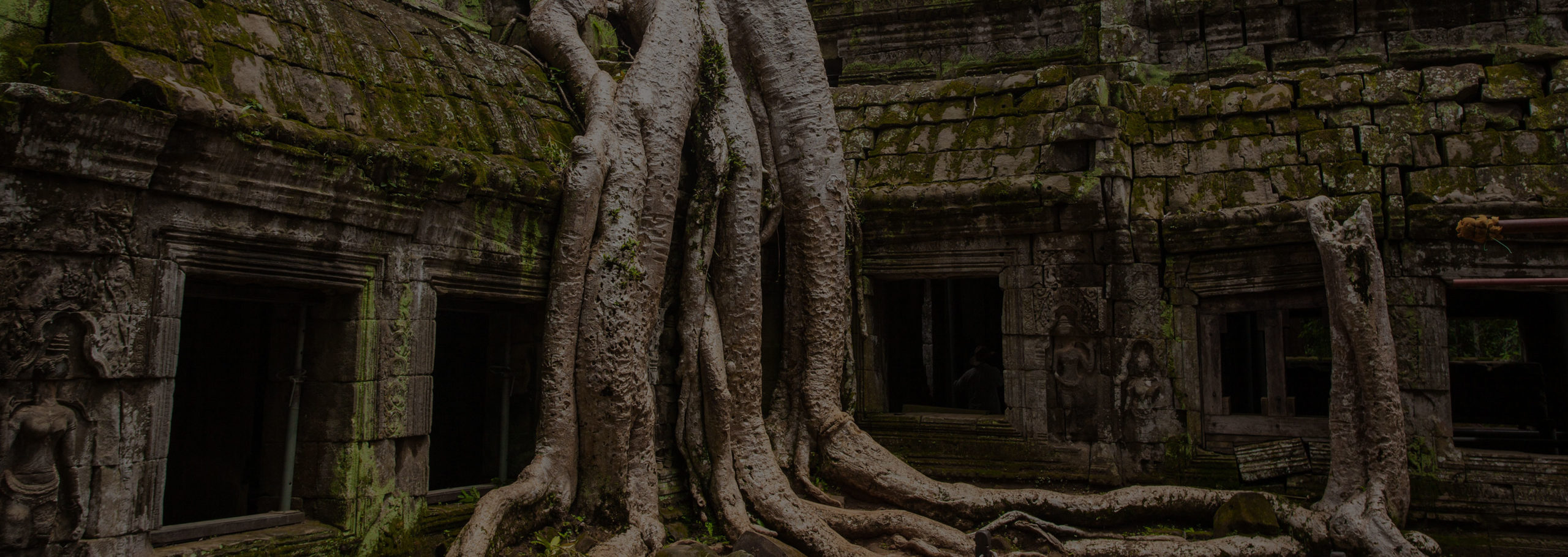
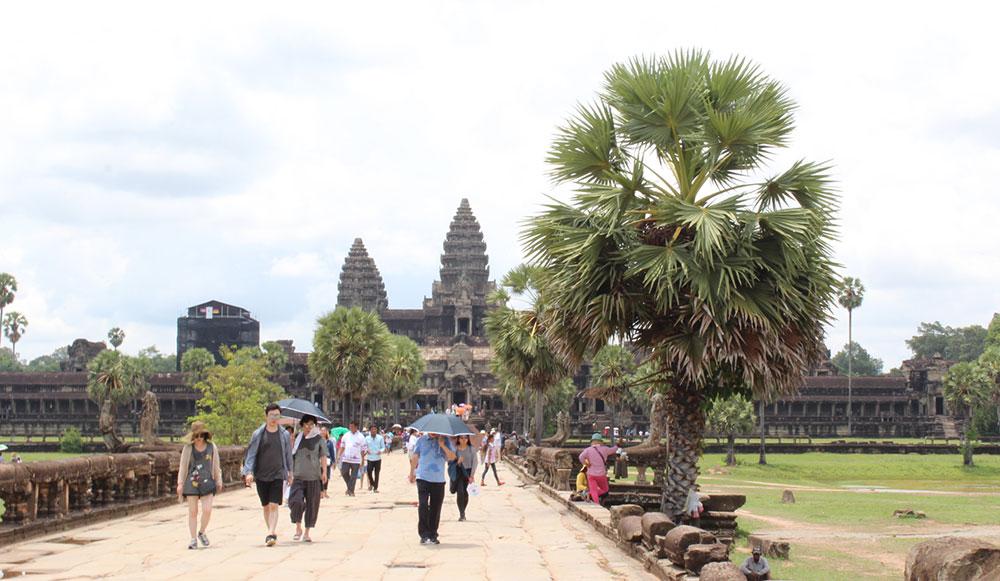
 Chilling inside the tuk tuk.
Chilling inside the tuk tuk.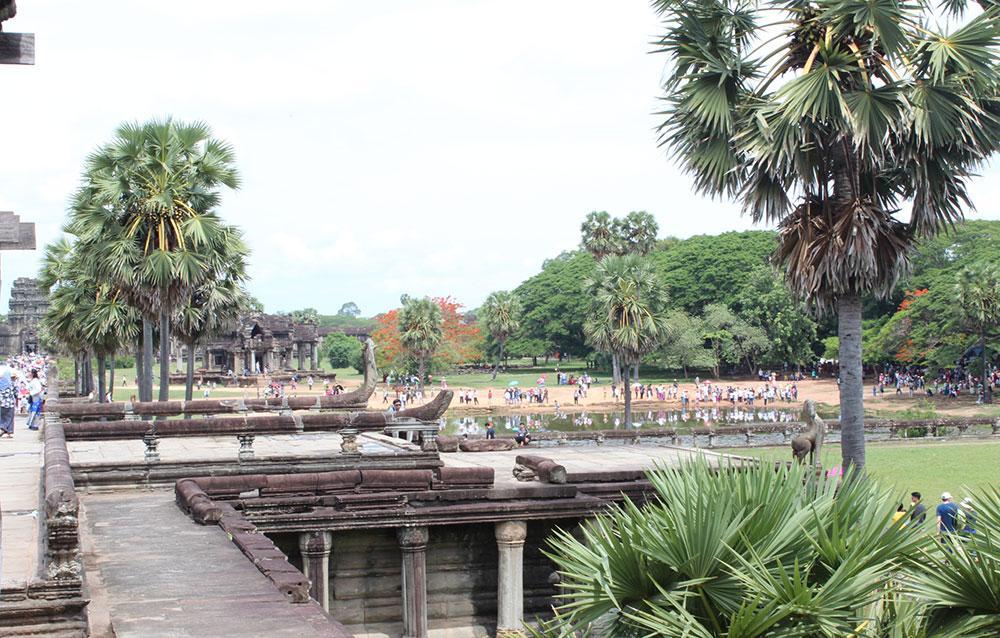
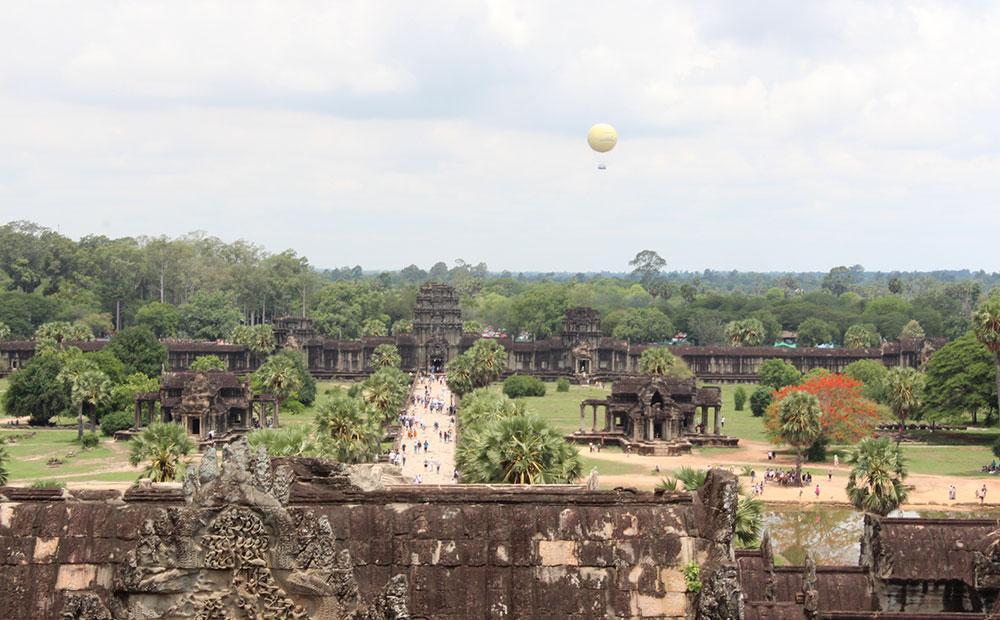

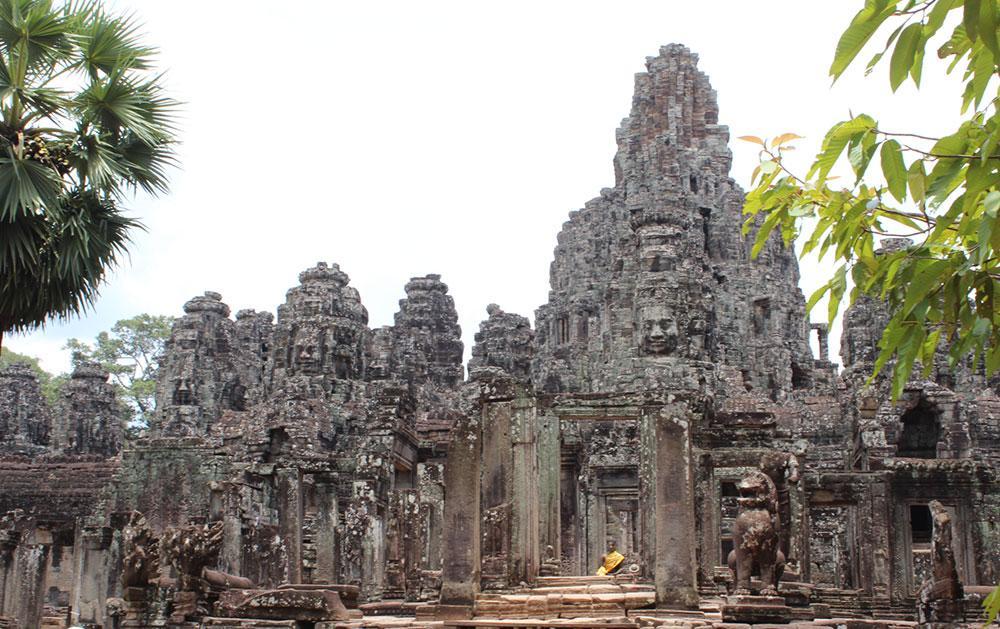
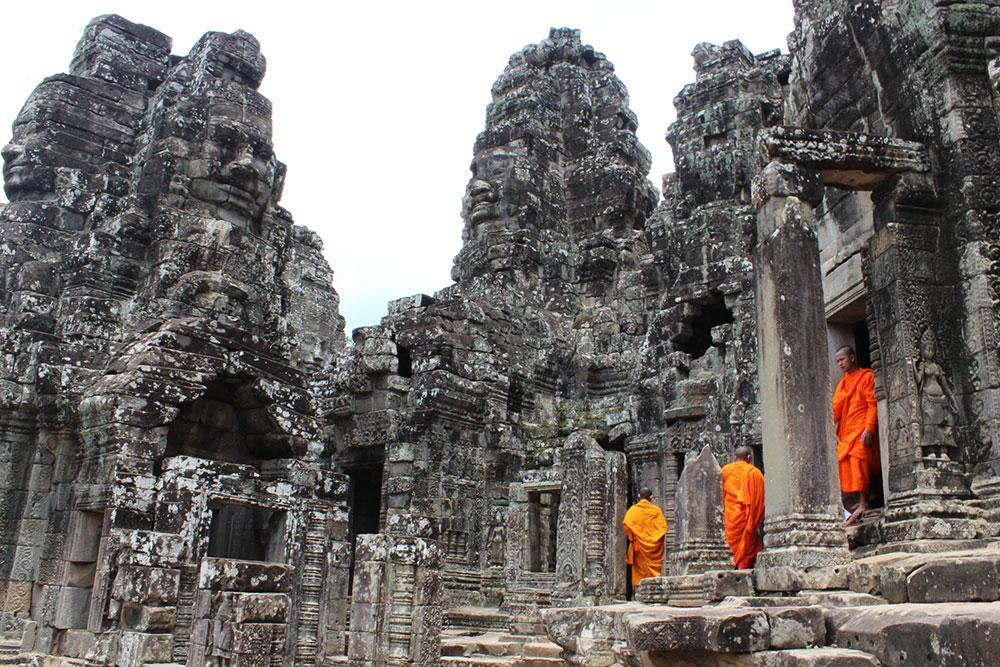
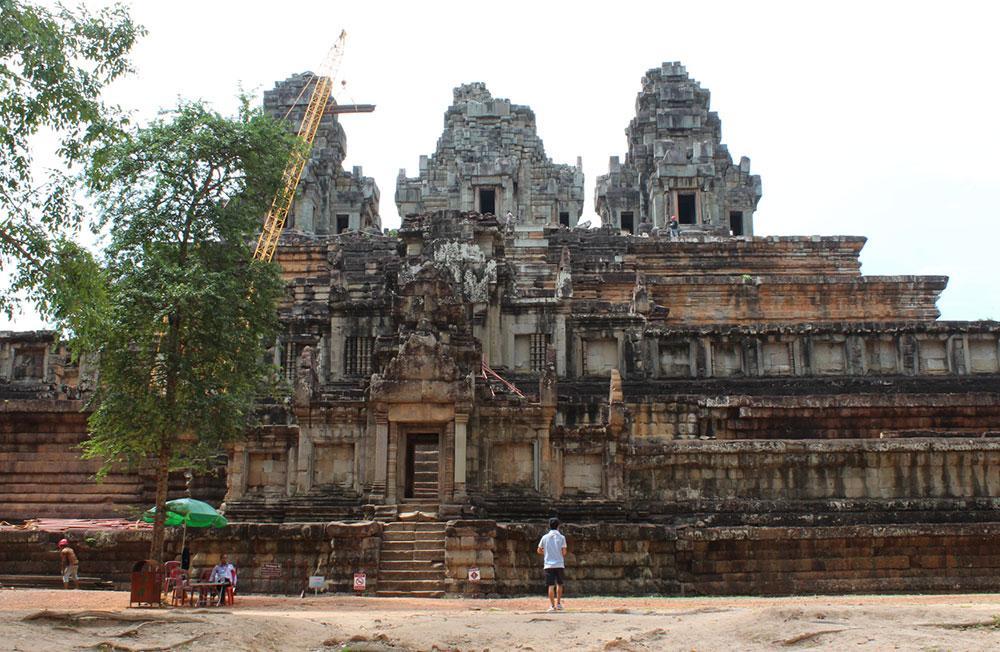

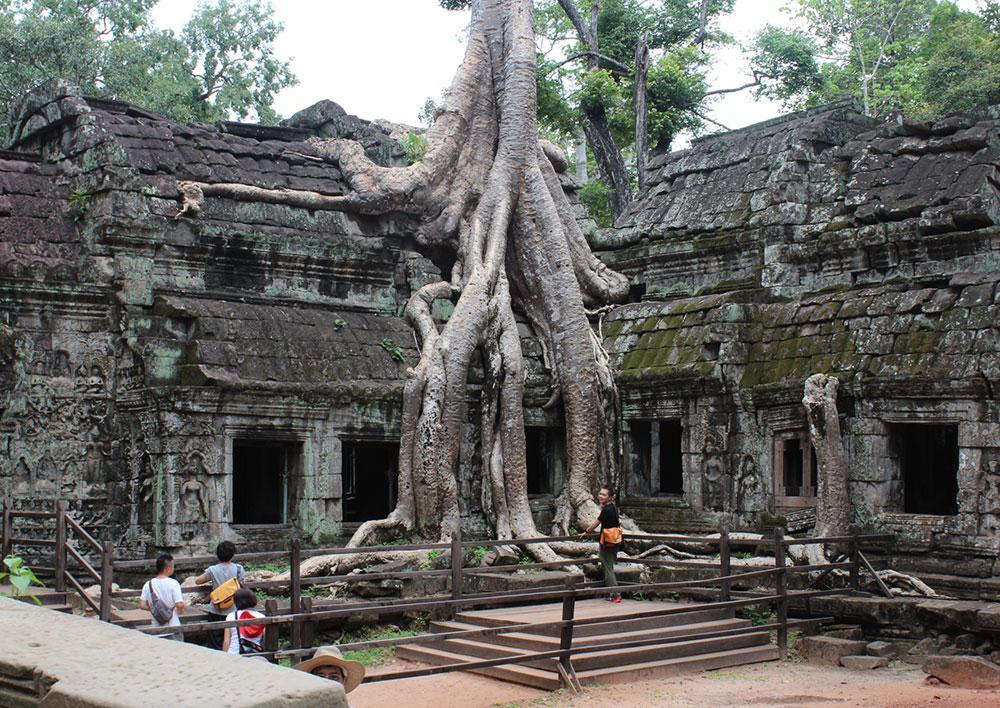
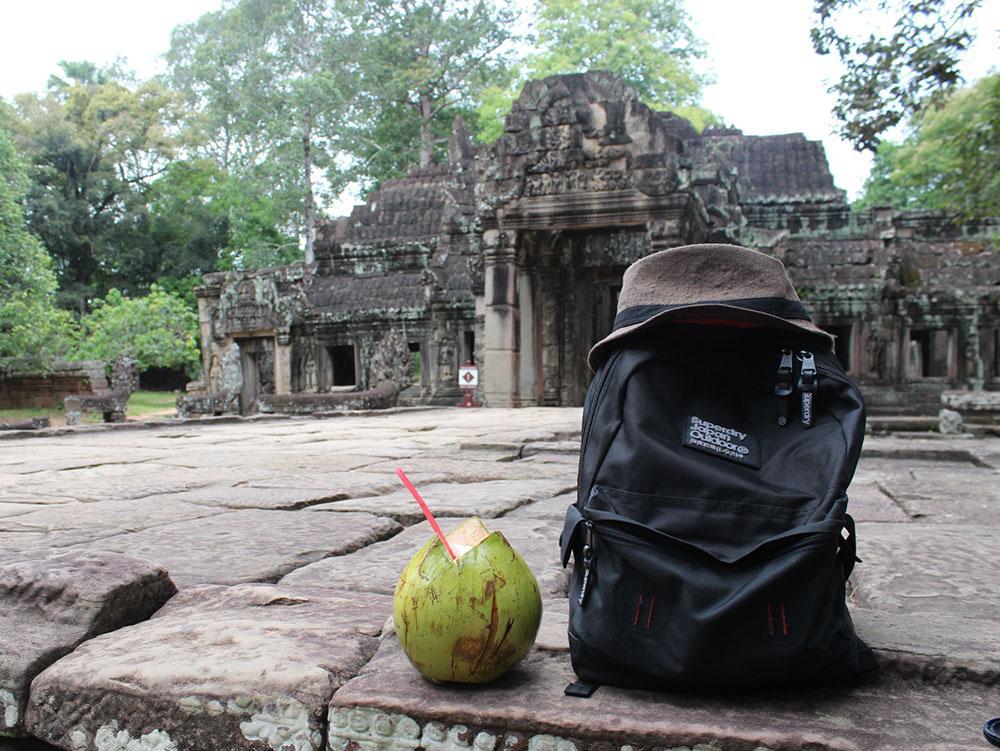
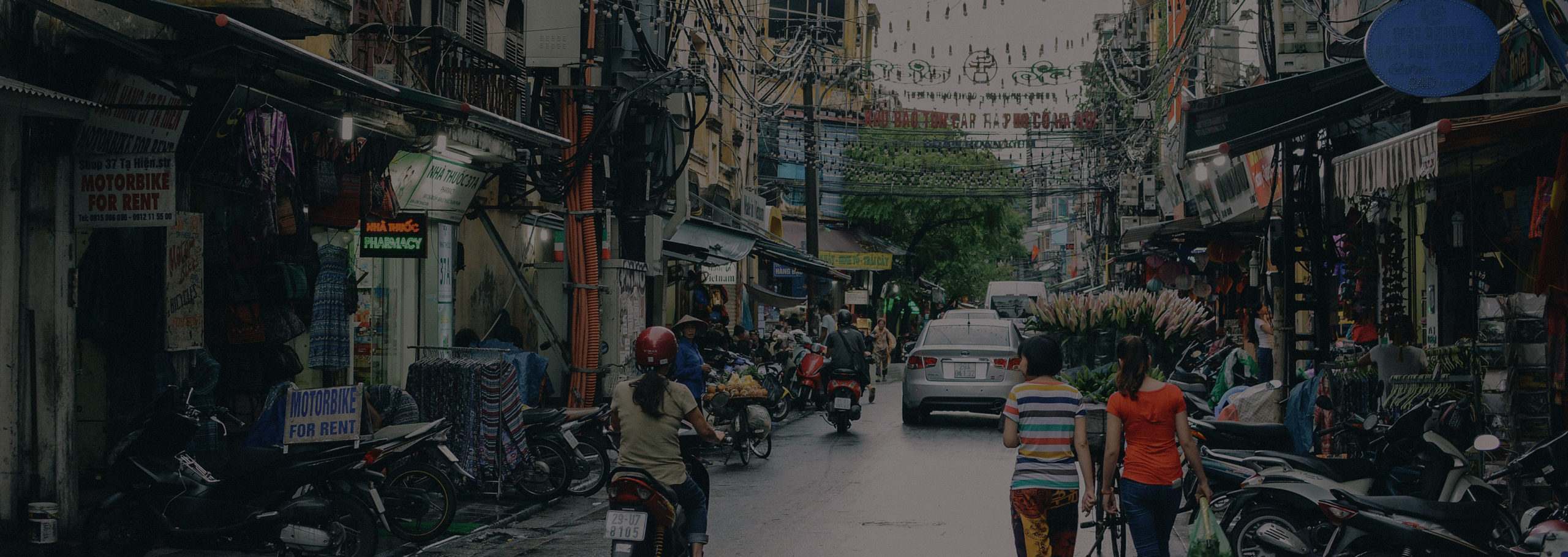
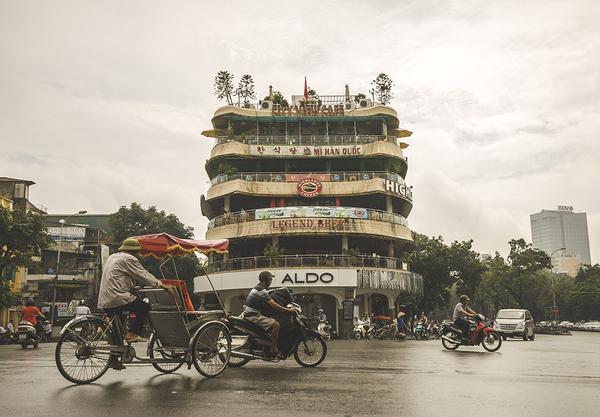
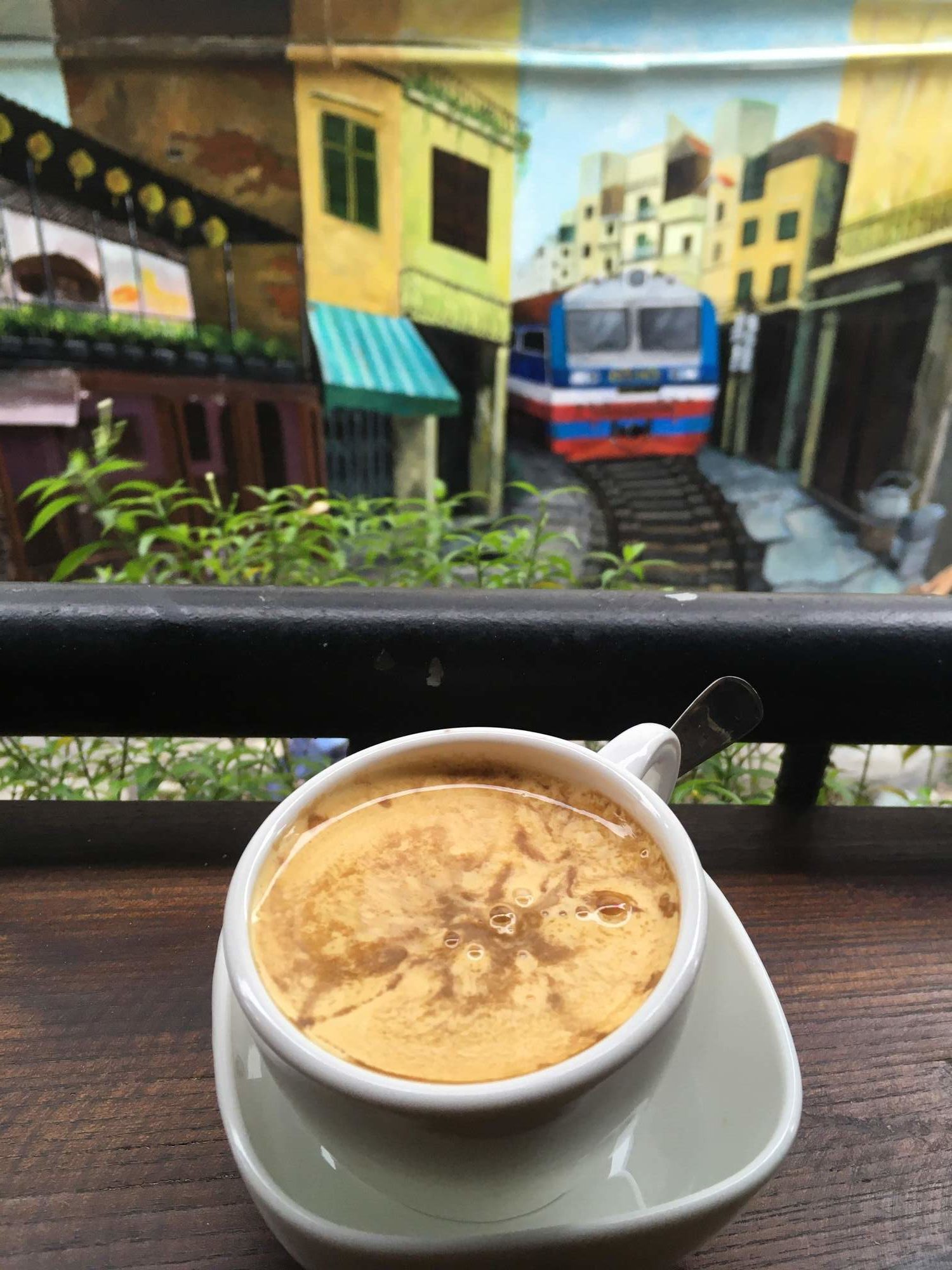 Egg coffee at the cafe A99.
Egg coffee at the cafe A99.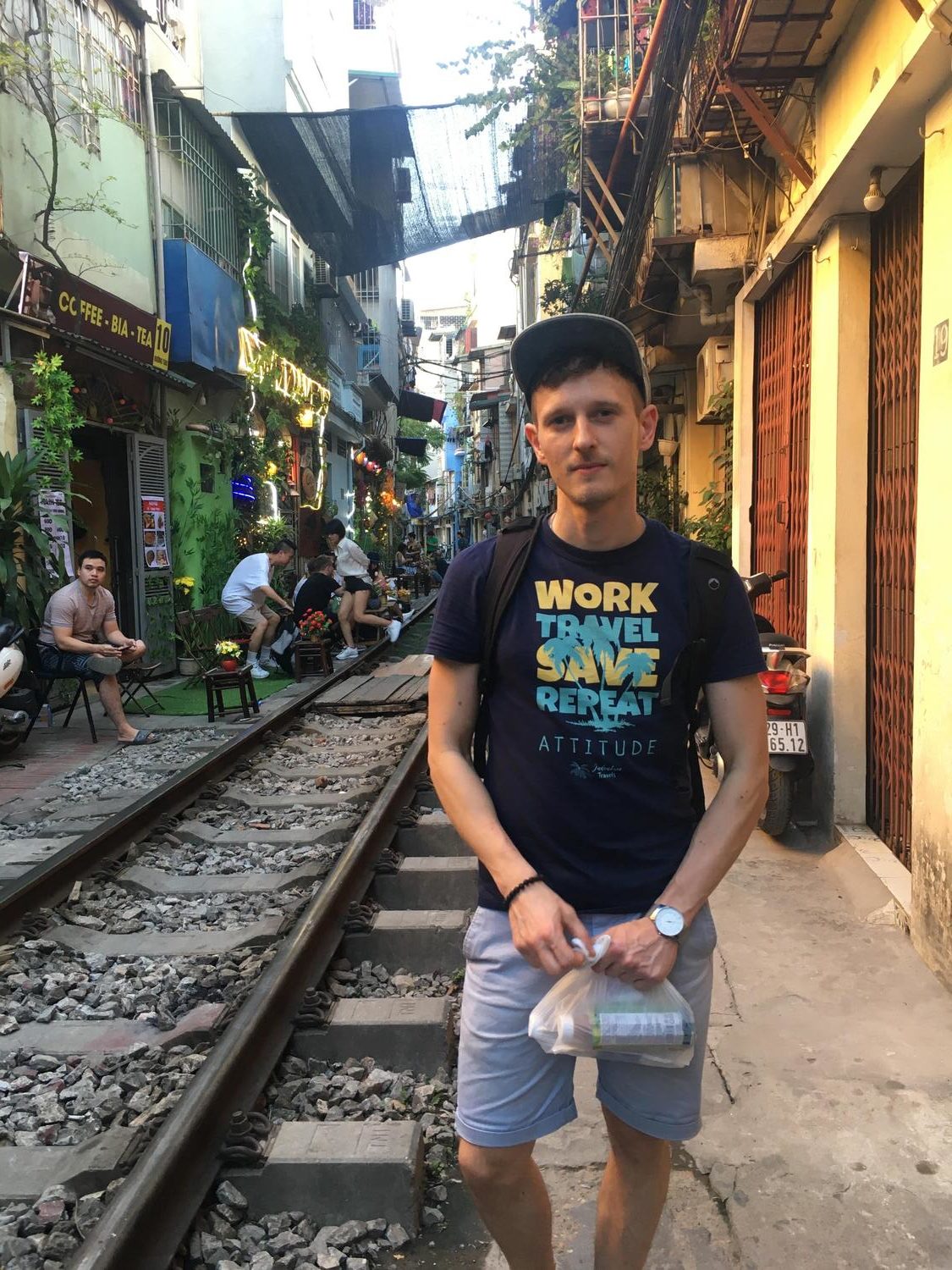 Enjoying the relaxed, urban vibes of the Train Street.
Enjoying the relaxed, urban vibes of the Train Street.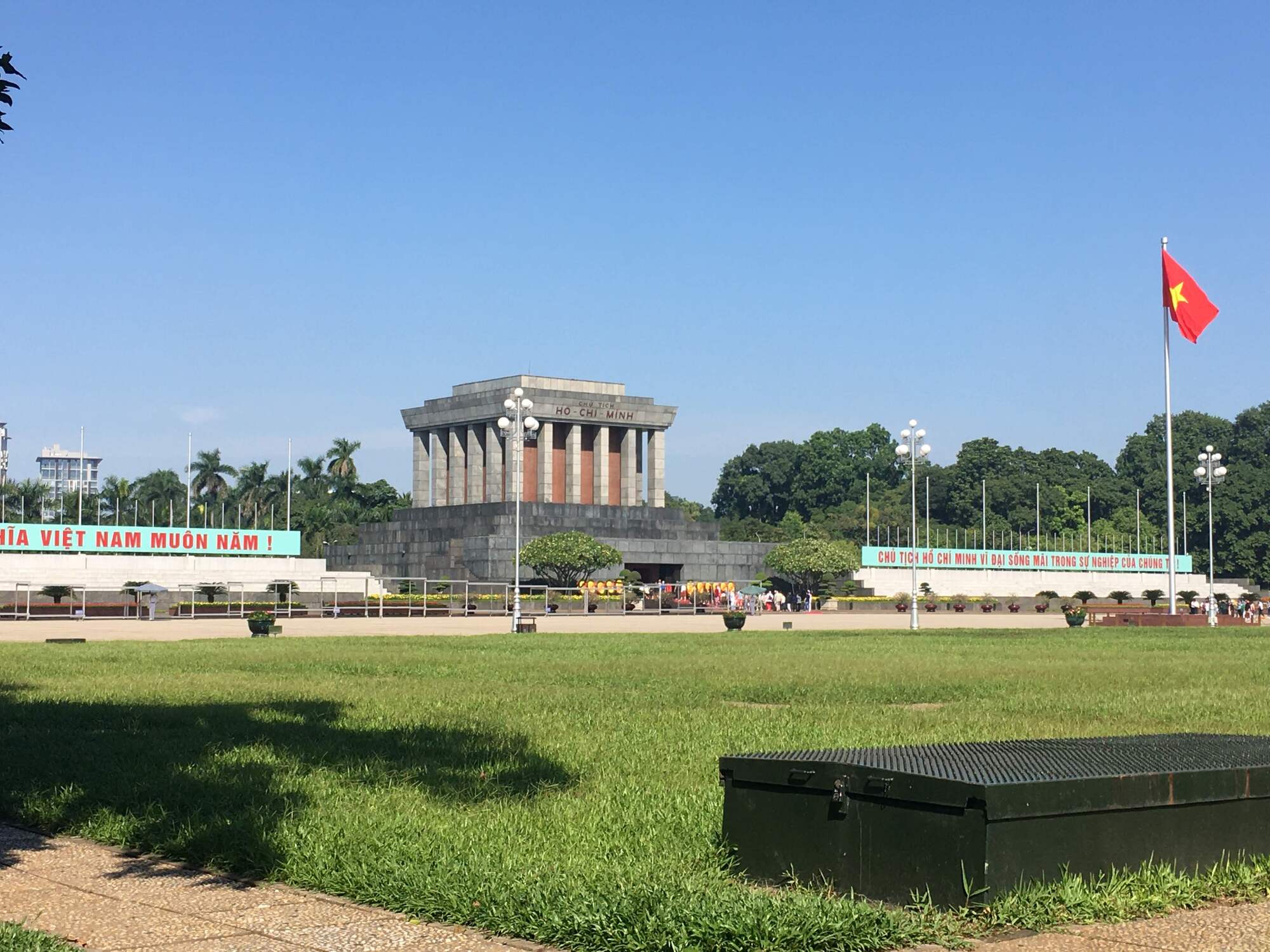
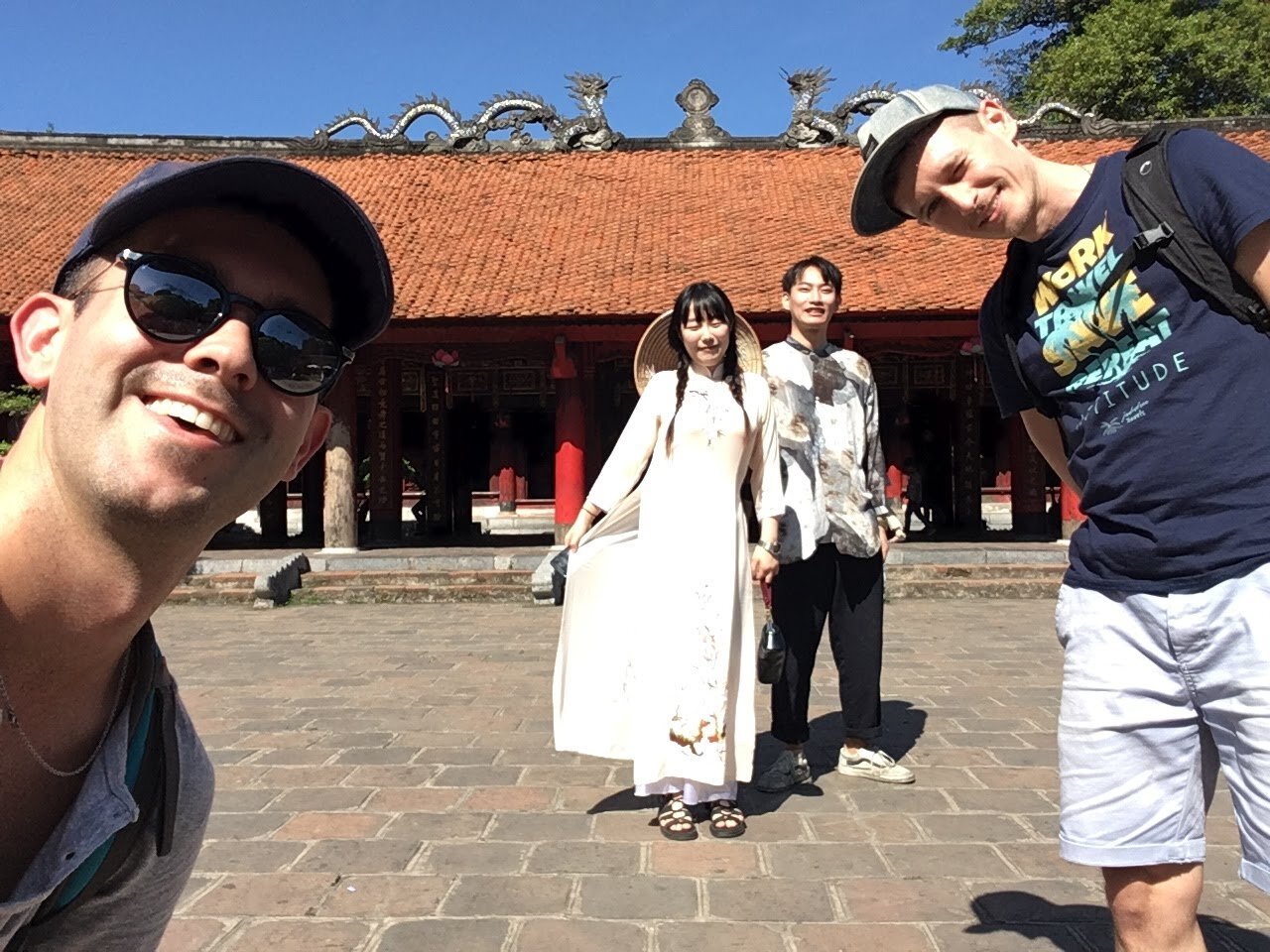 Photobombing a couple in a traditional outfit.
Photobombing a couple in a traditional outfit.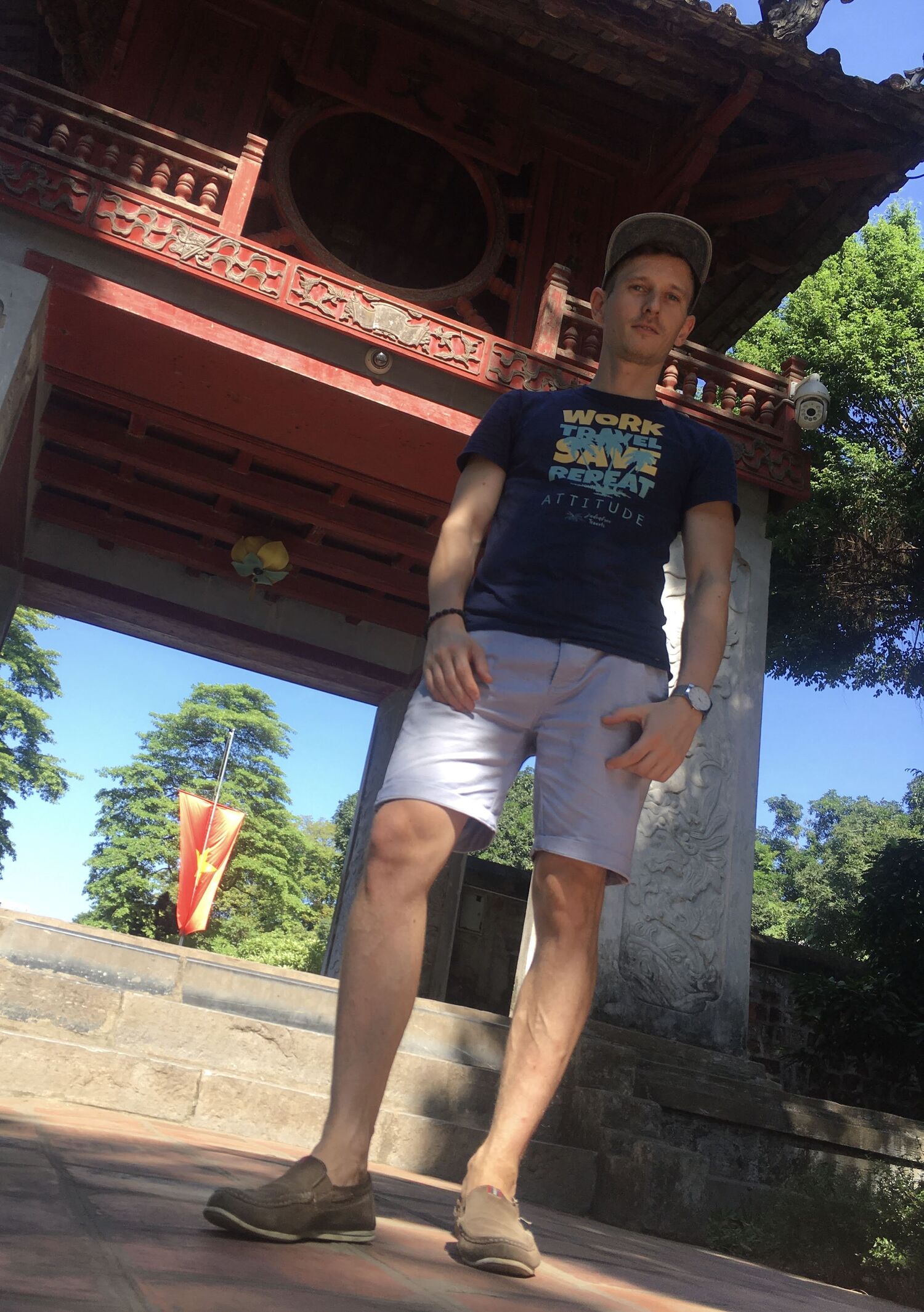 At the entrance to the temple.
At the entrance to the temple.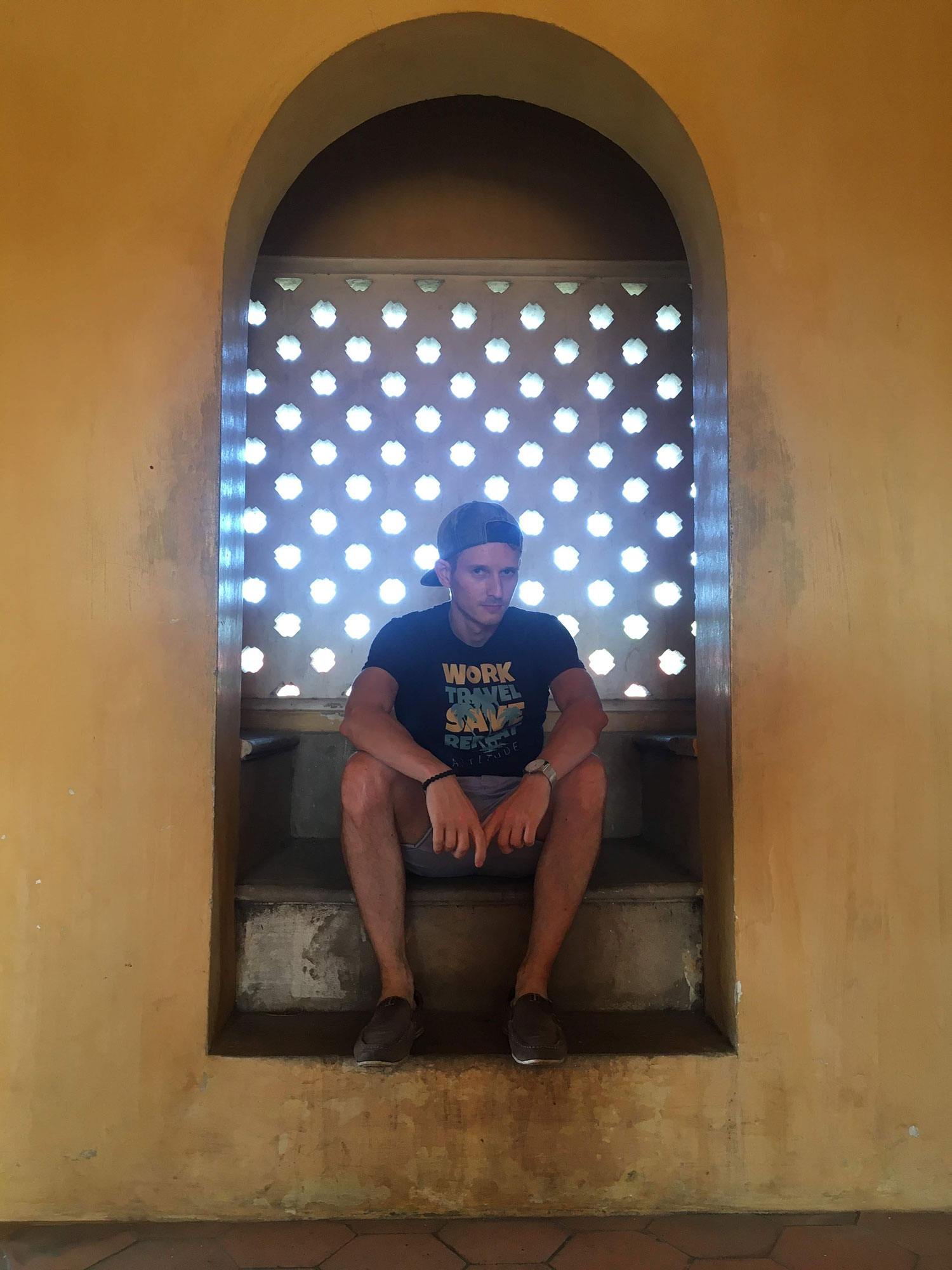 Inside the citadel complex.
Inside the citadel complex.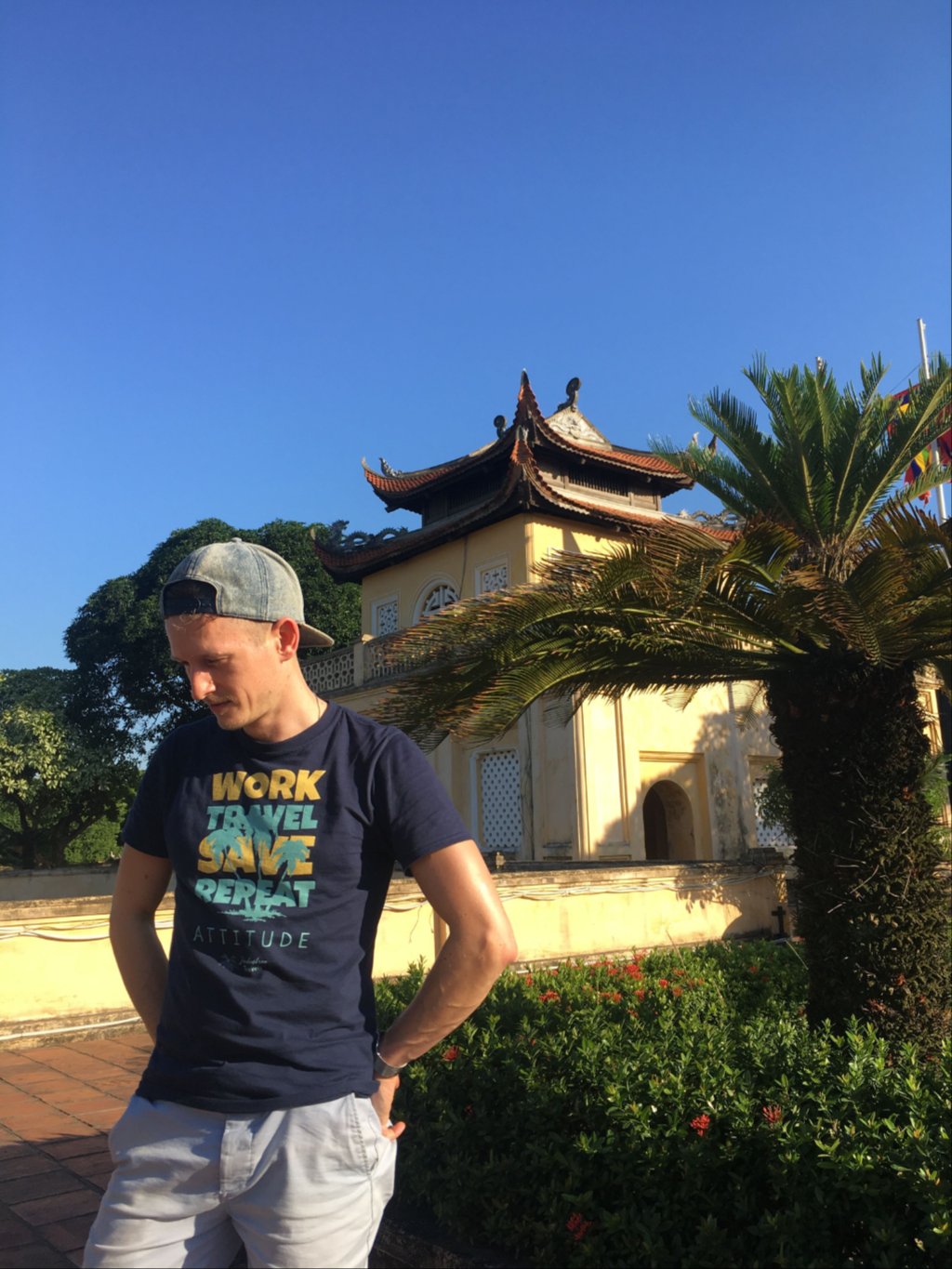 Posing in front of a citadel tower.
Posing in front of a citadel tower.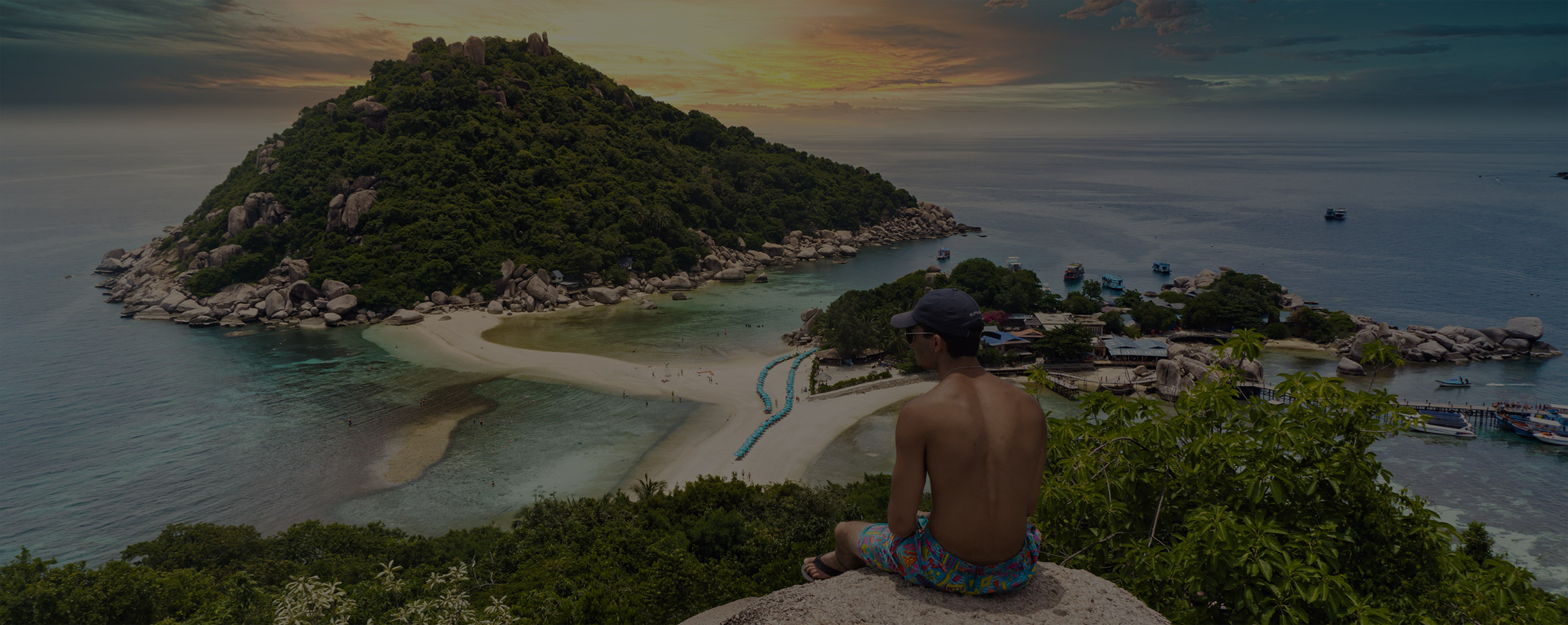

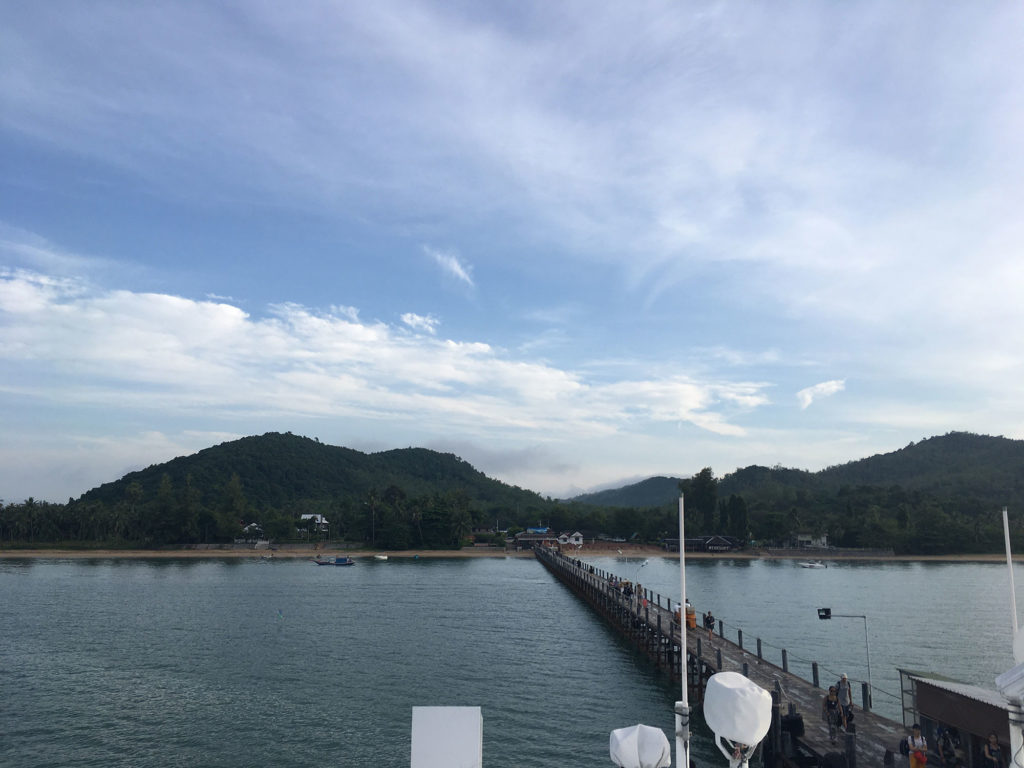 Departure dock for Ko Tao.
Departure dock for Ko Tao.
 Nang Yuan at Ko Tao.
Nang Yuan at Ko Tao.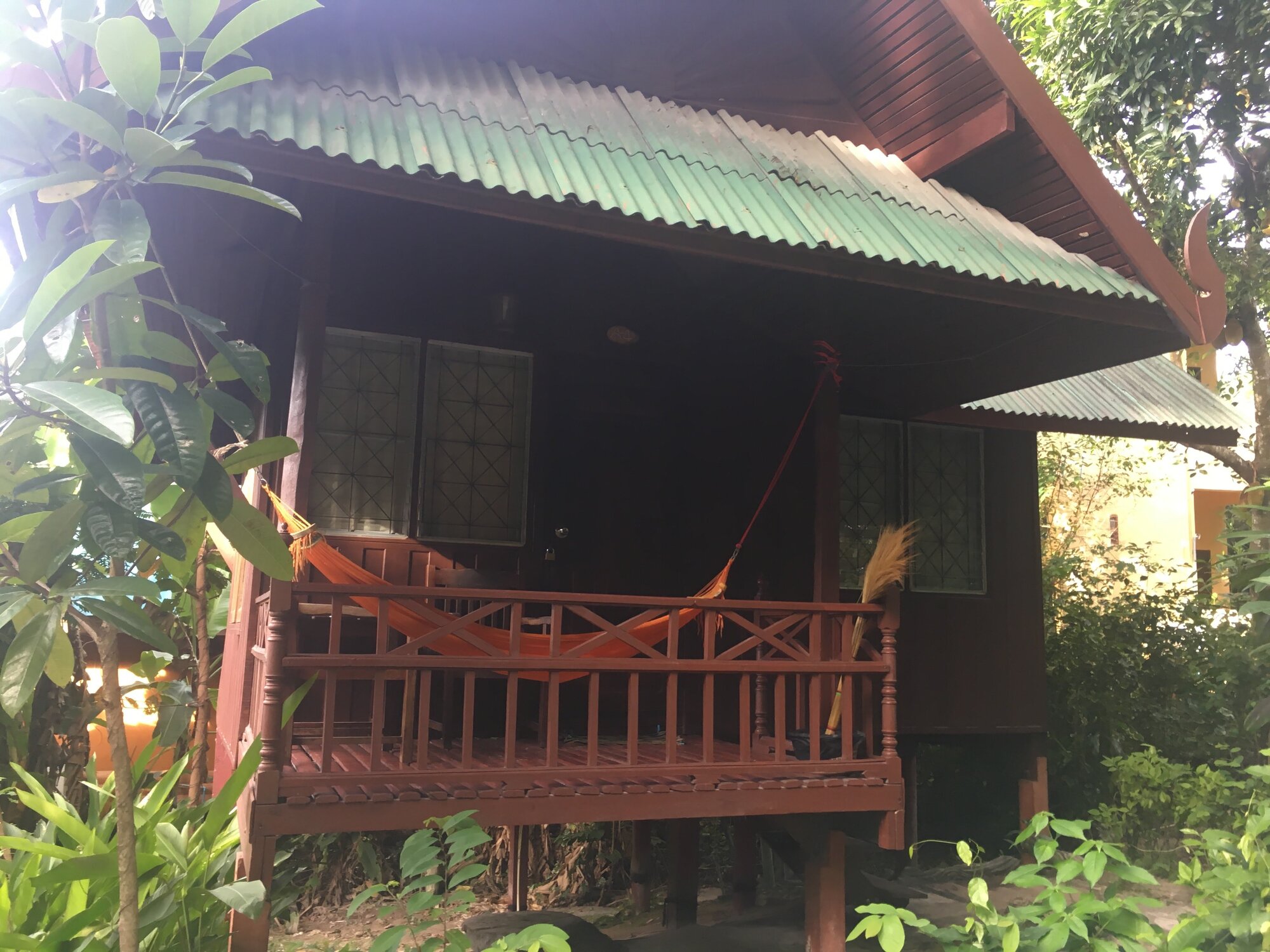
 Hanging out in the bungalows.
Hanging out in the bungalows.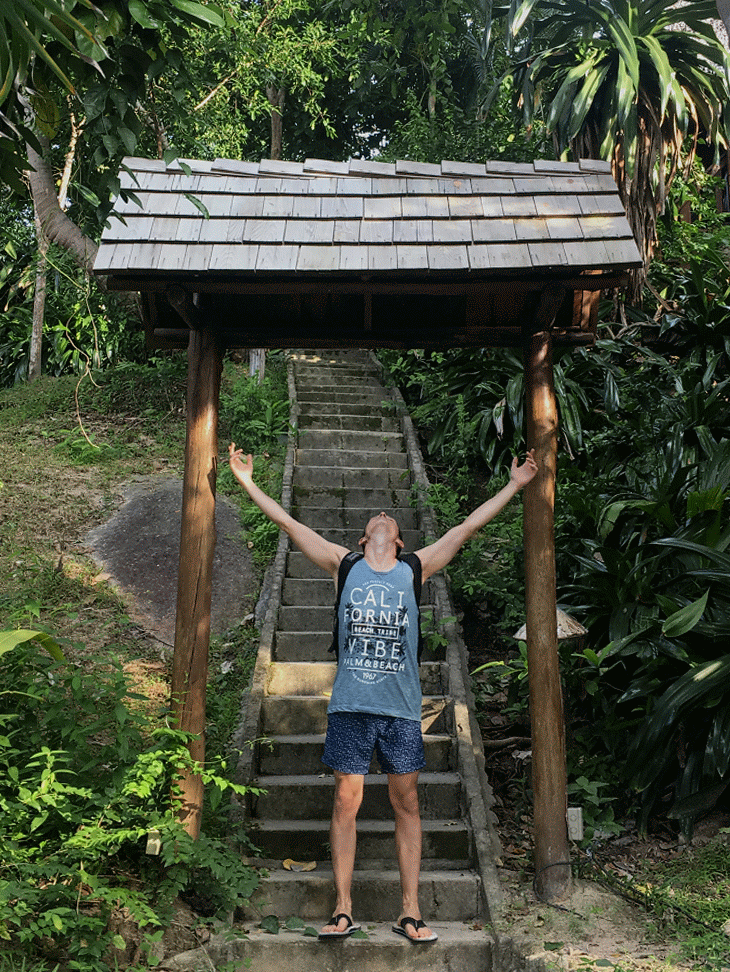
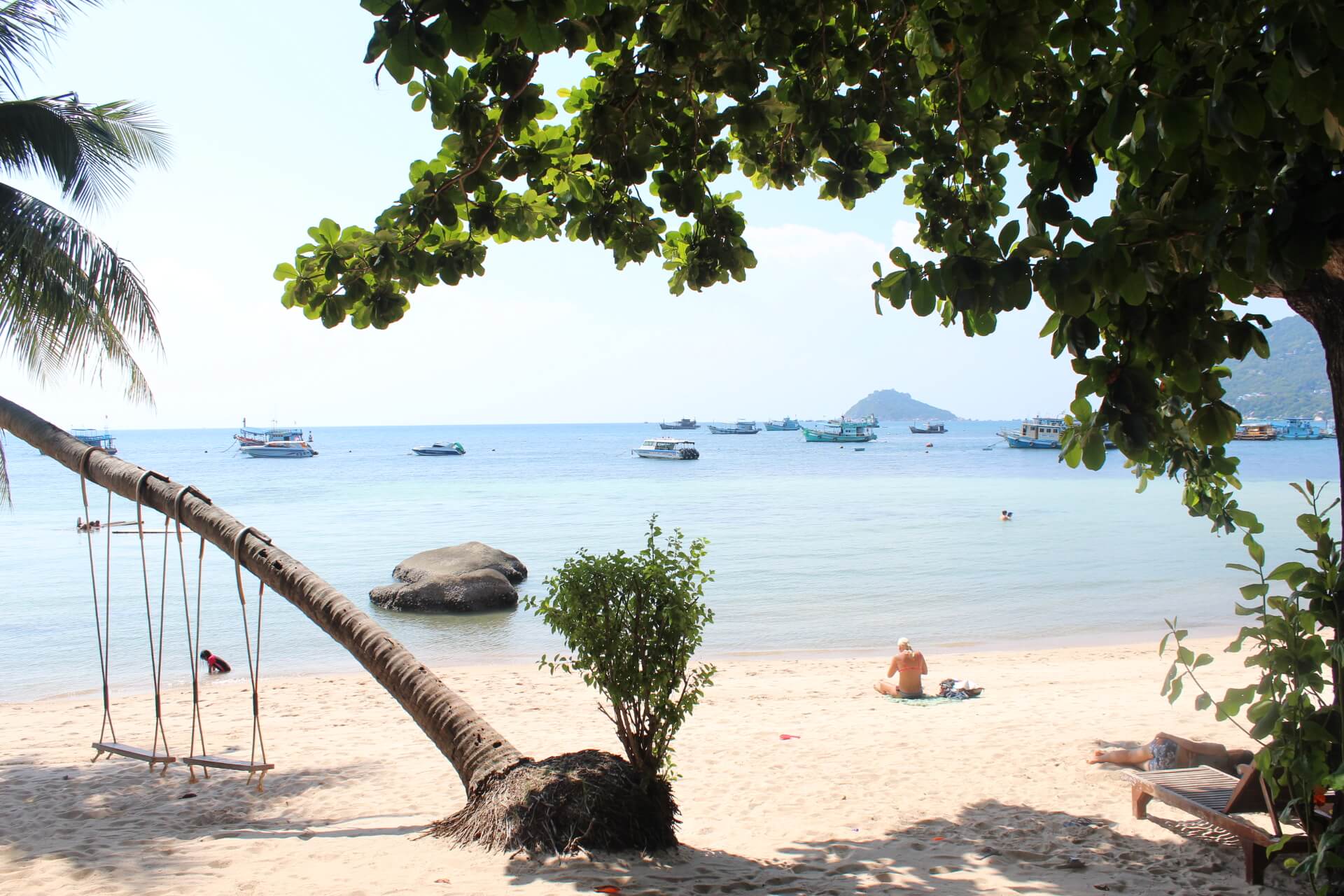
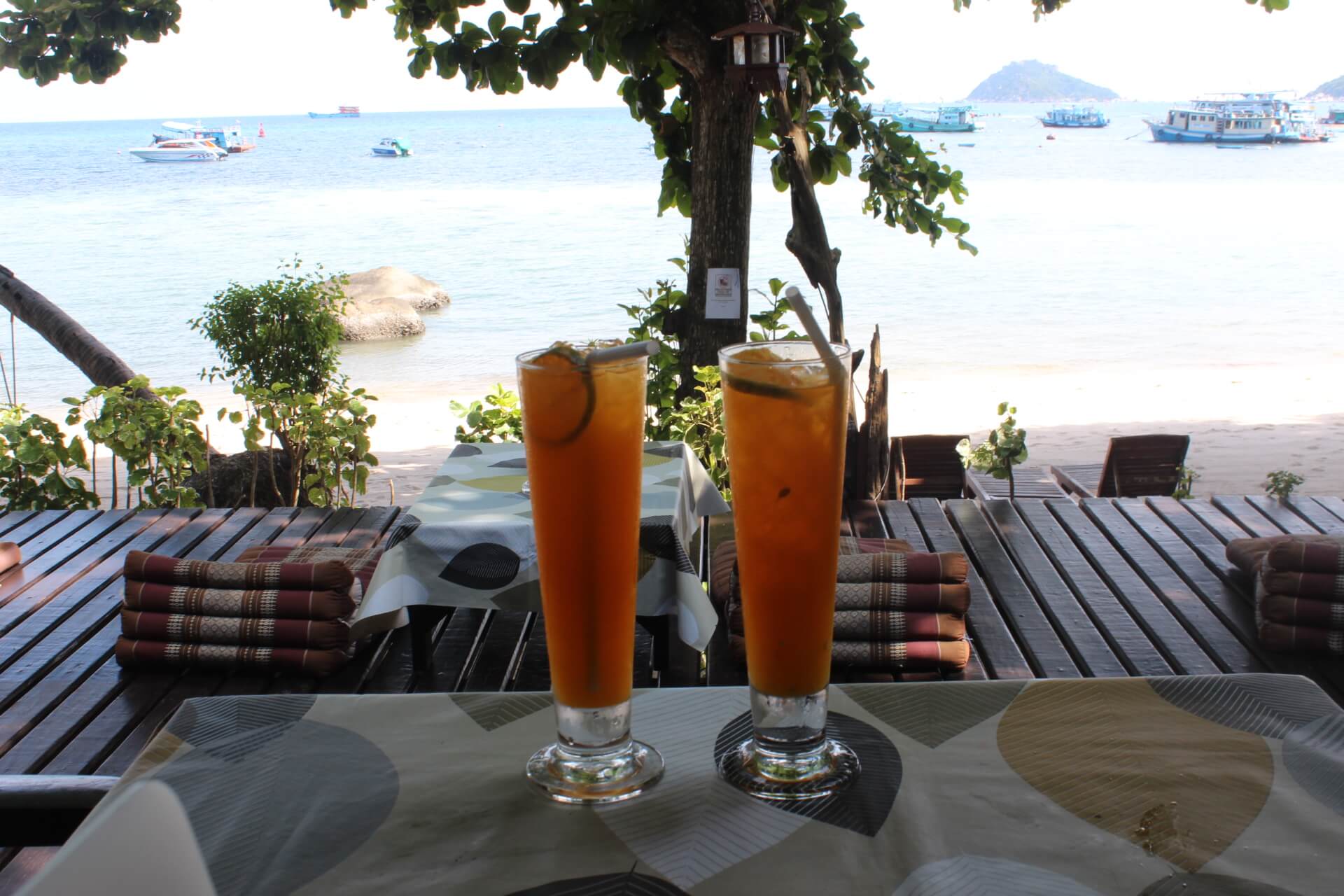
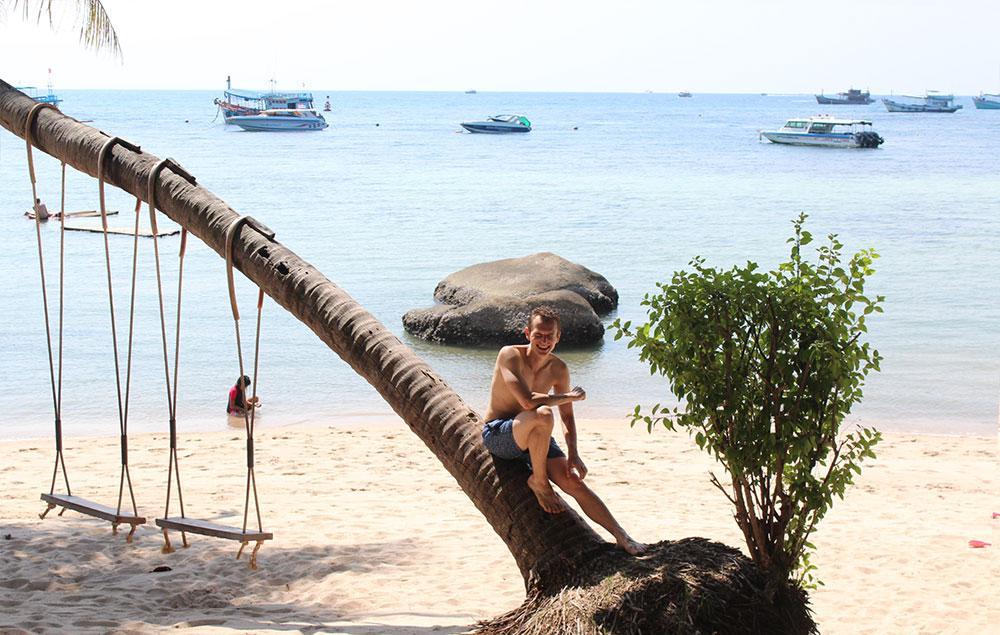 Beach nearby our bungalow.
Beach nearby our bungalow.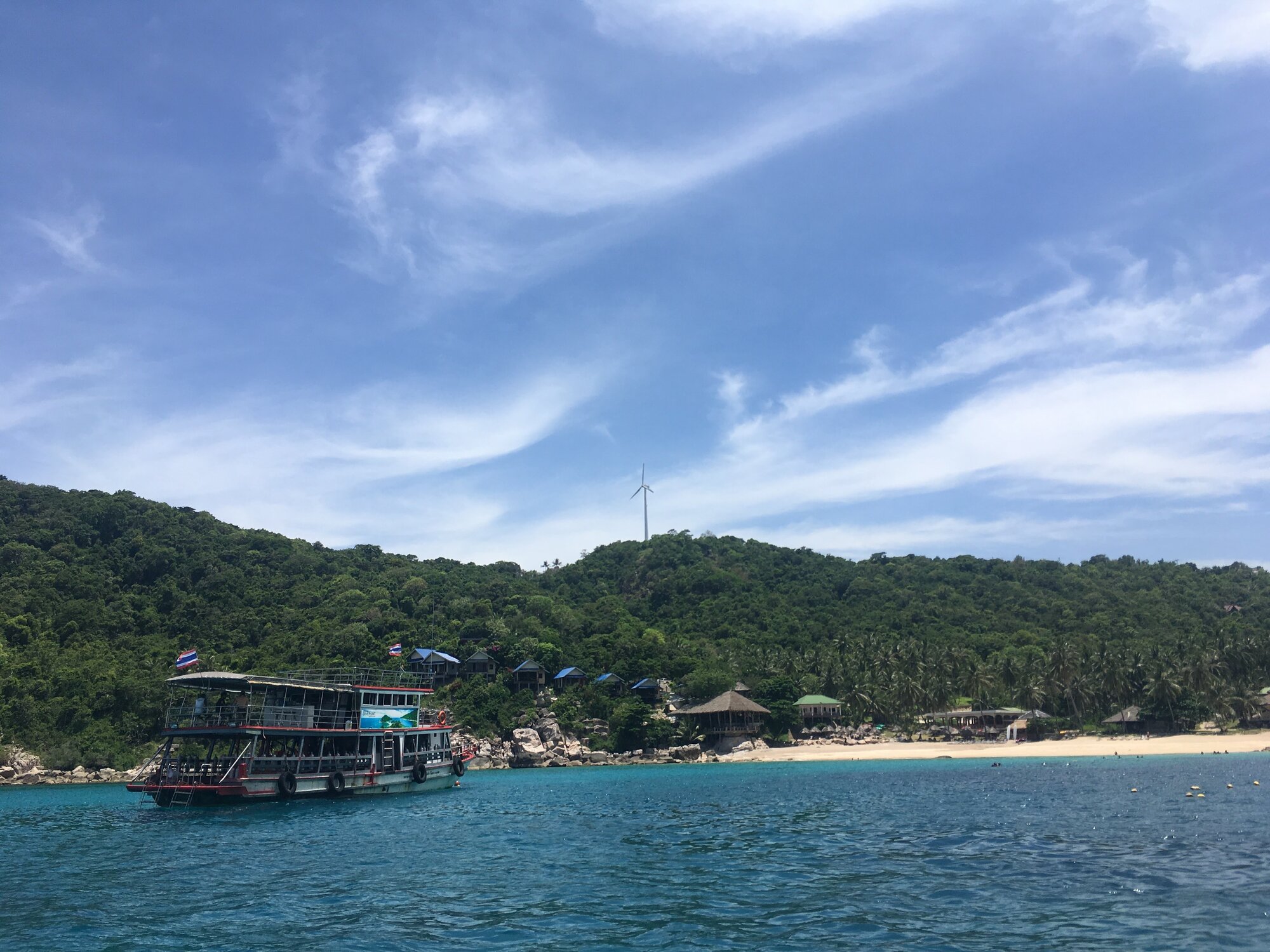
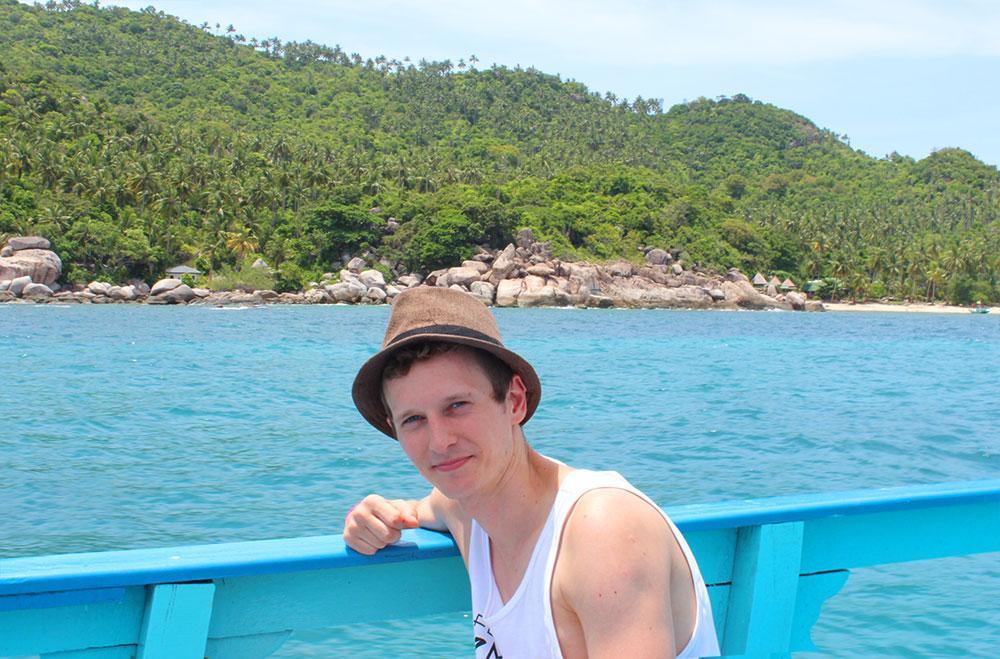
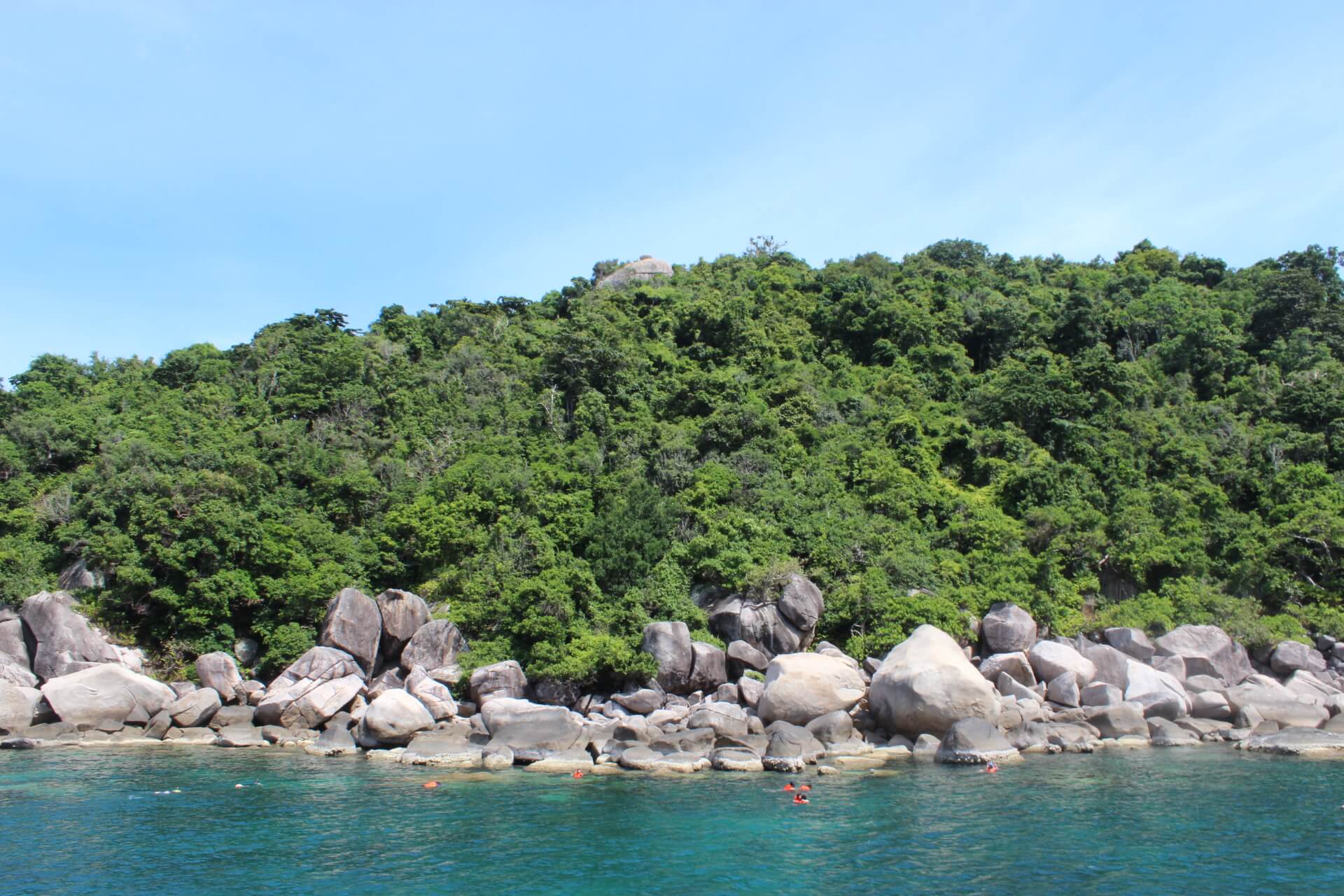 The views from the boat.
The views from the boat.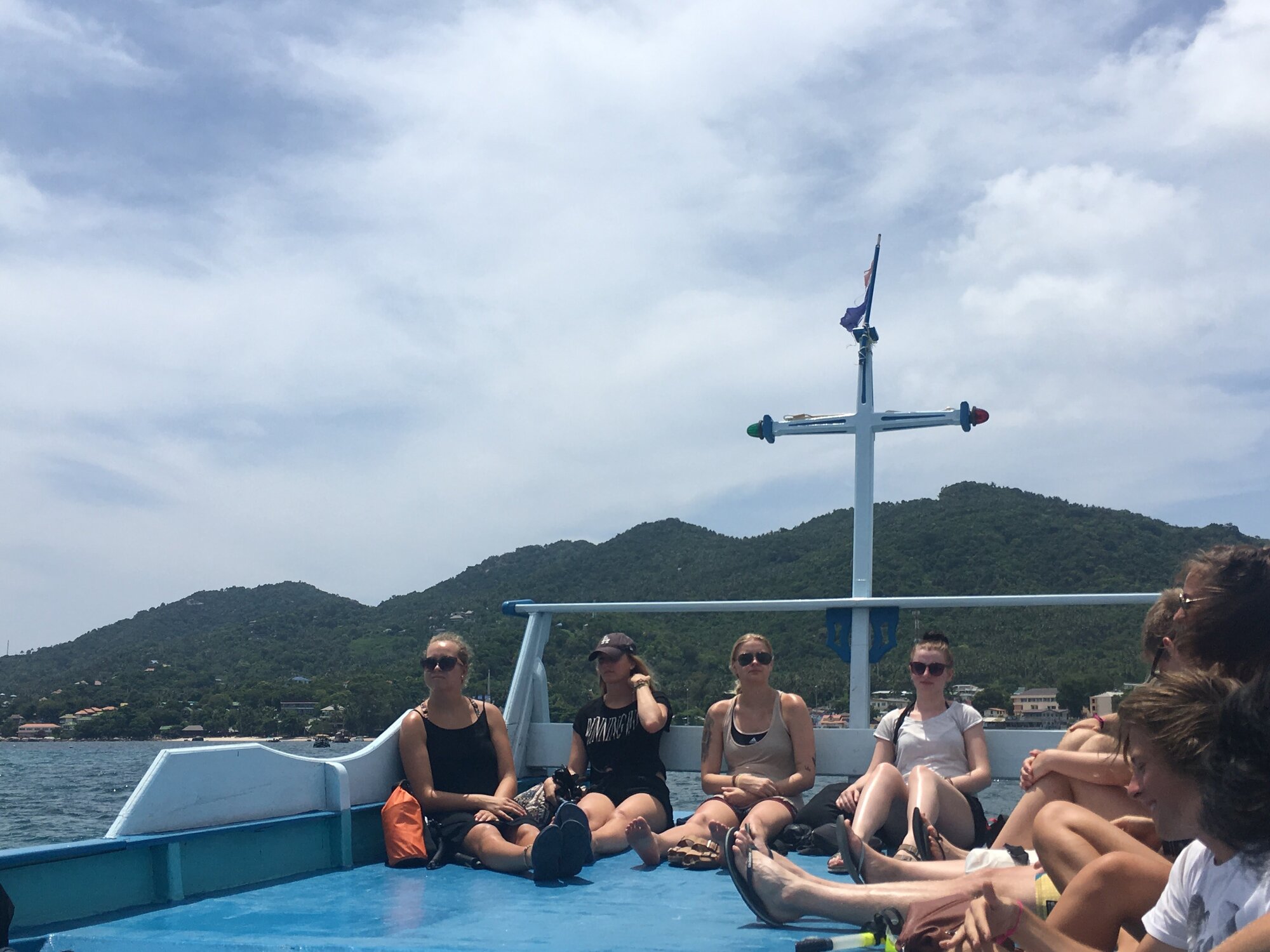
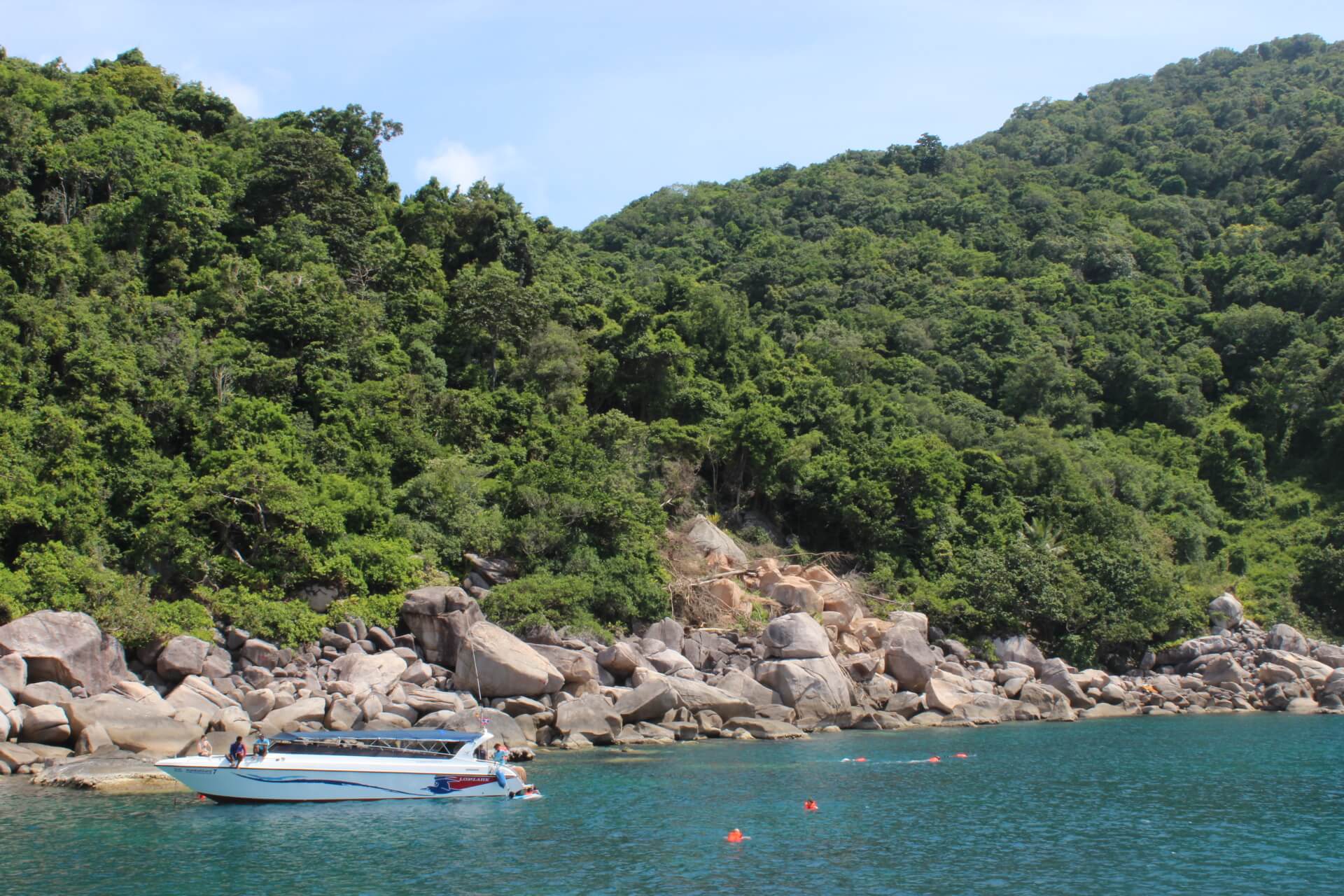
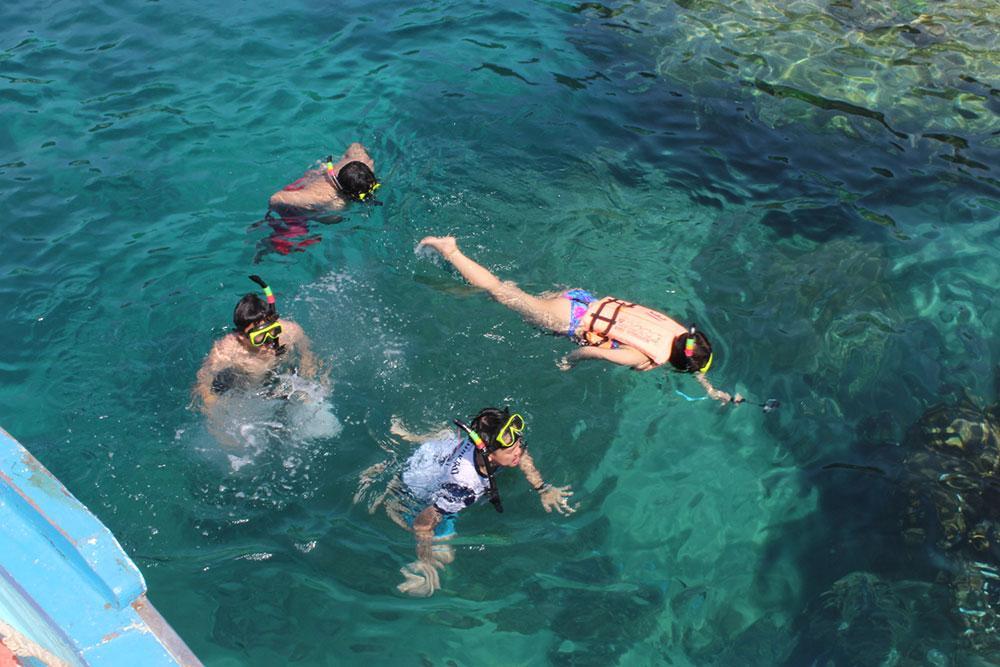
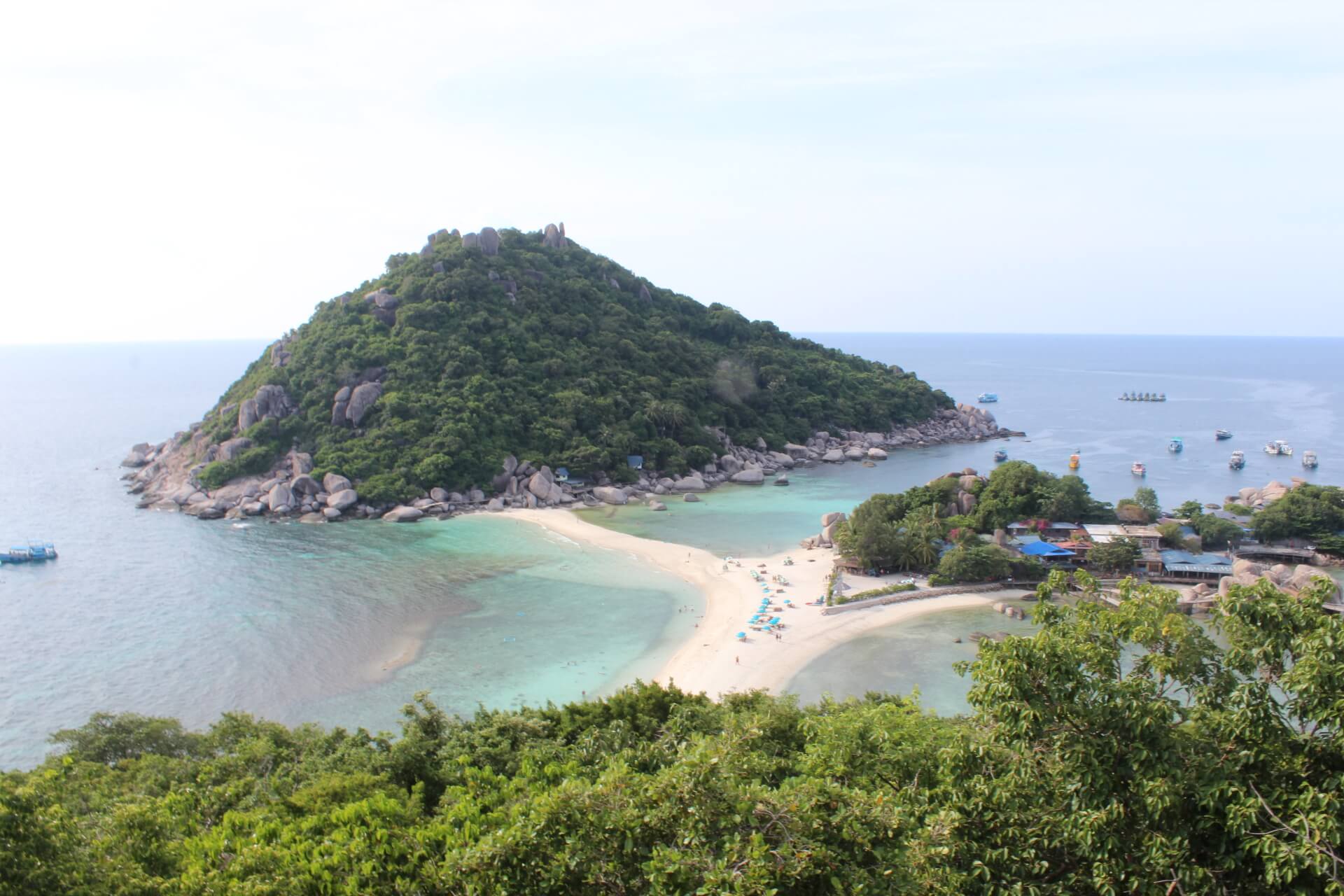 Majestic view from the hill top.
Majestic view from the hill top.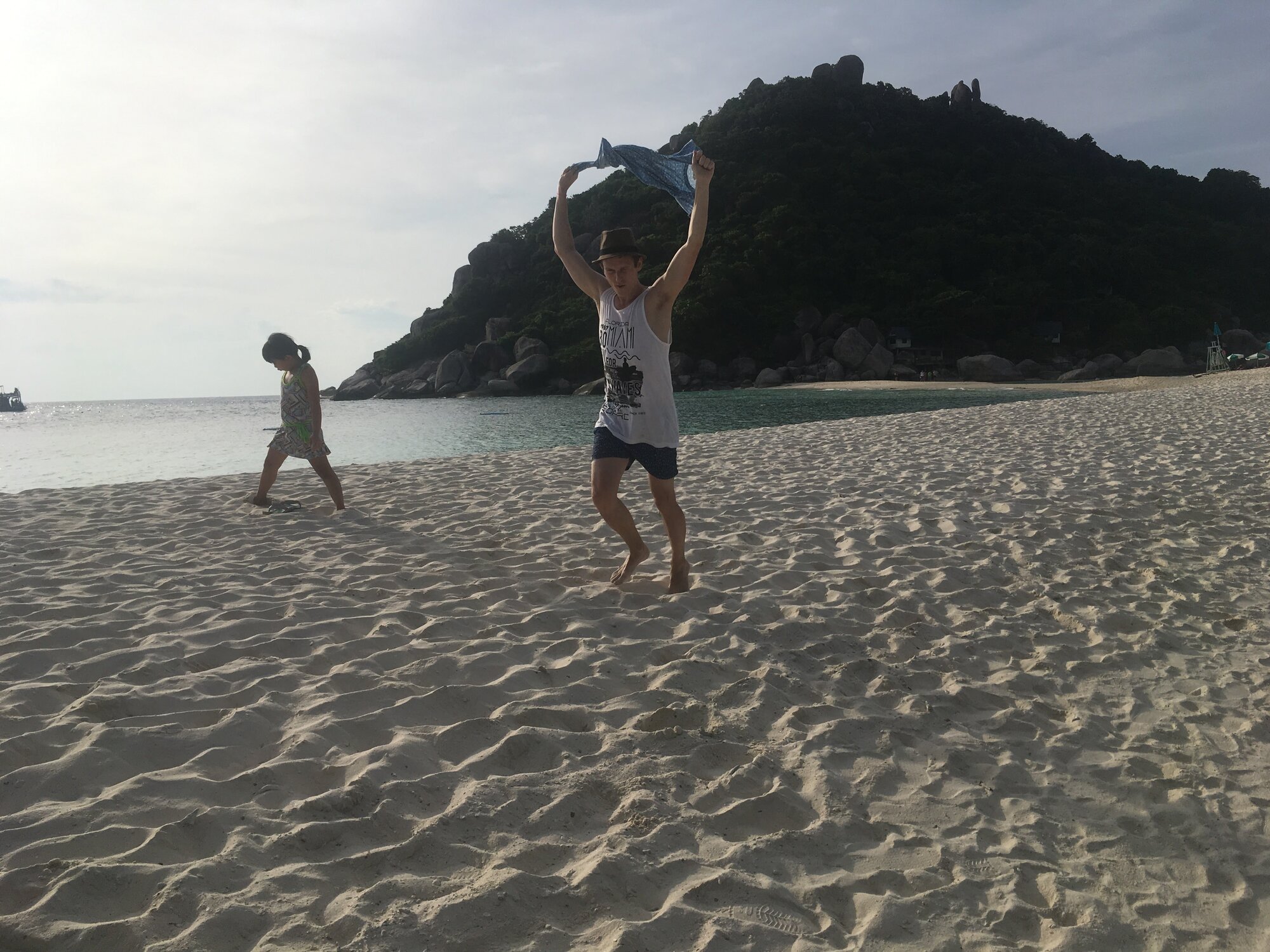 The feeling of freedom.
The feeling of freedom.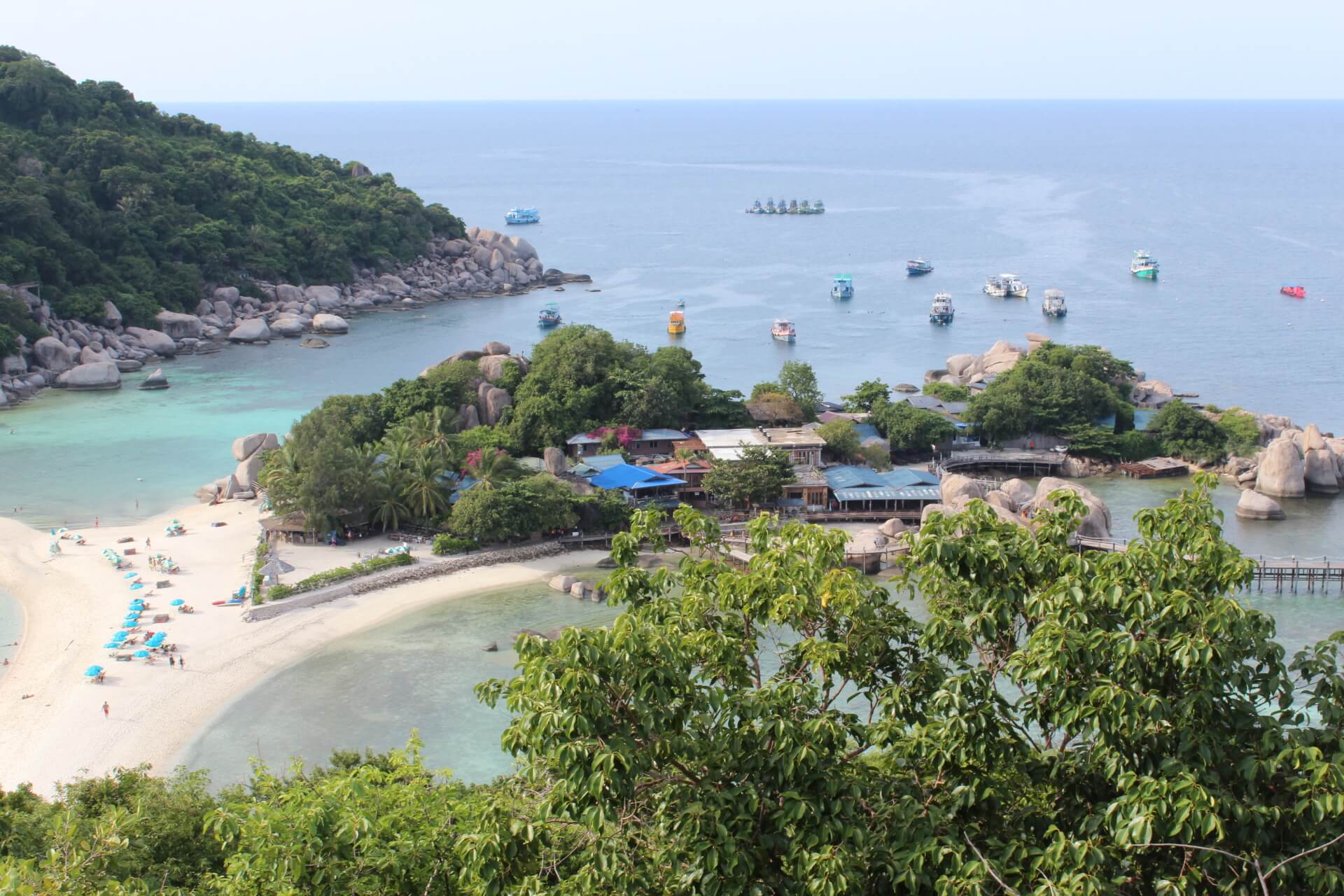 The resort of Nang Yuan.
The resort of Nang Yuan.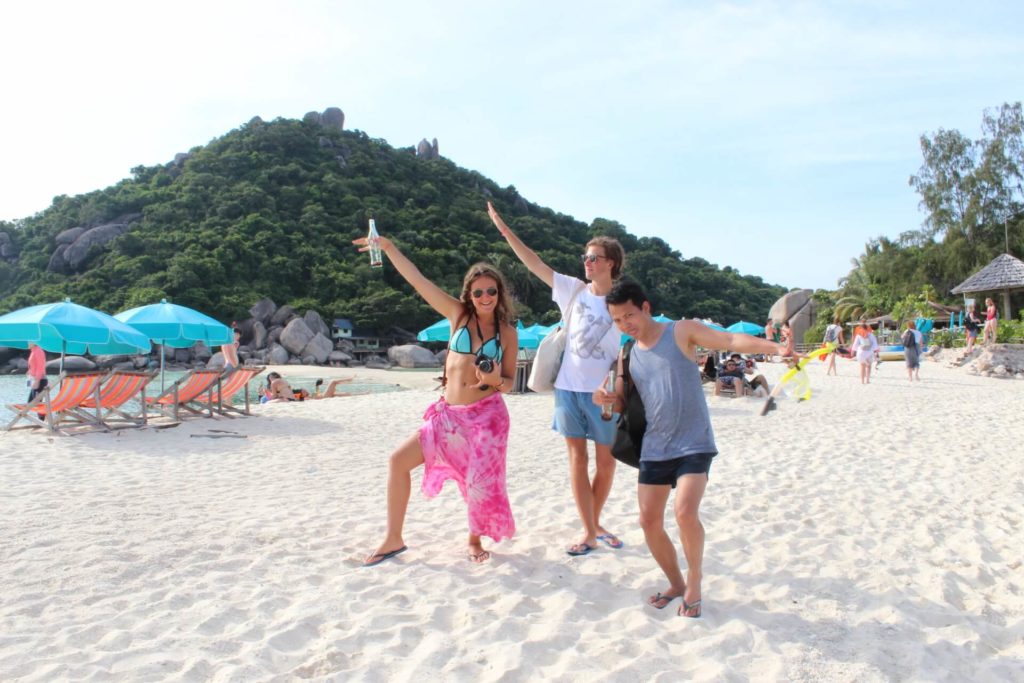 Fun with friends.
Fun with friends.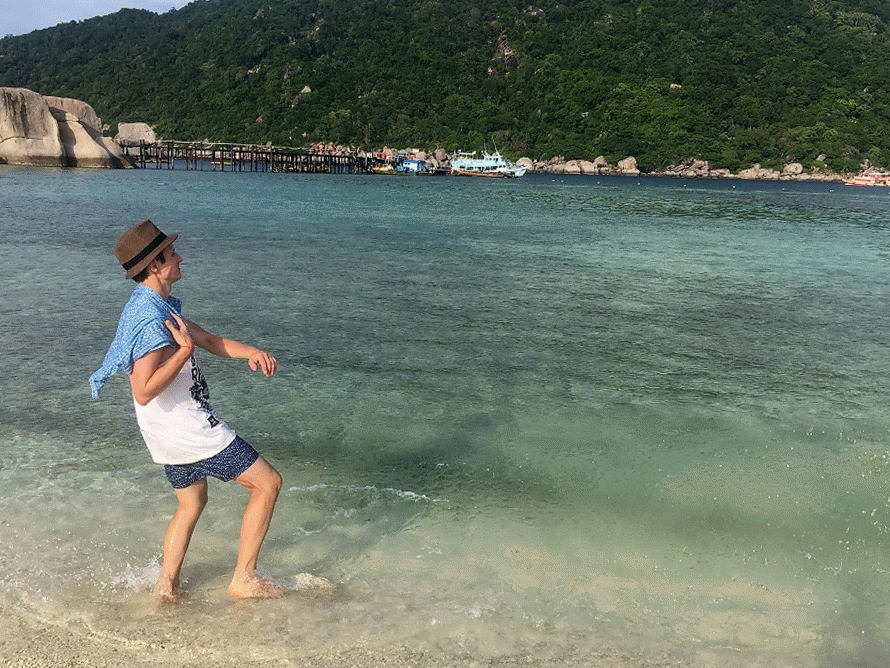
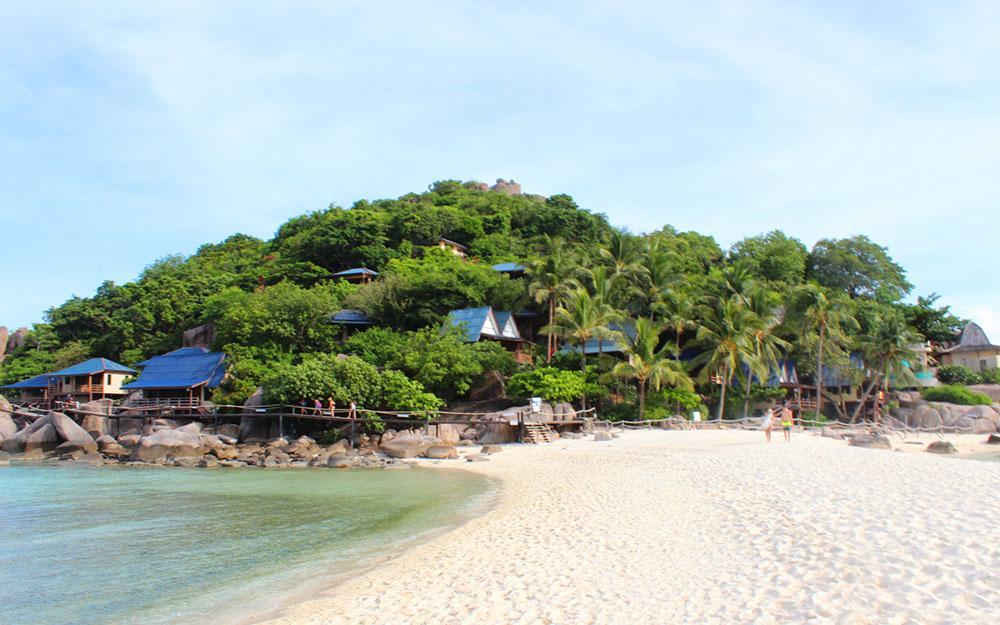 The beach of Ko Nang Yuan.
The beach of Ko Nang Yuan.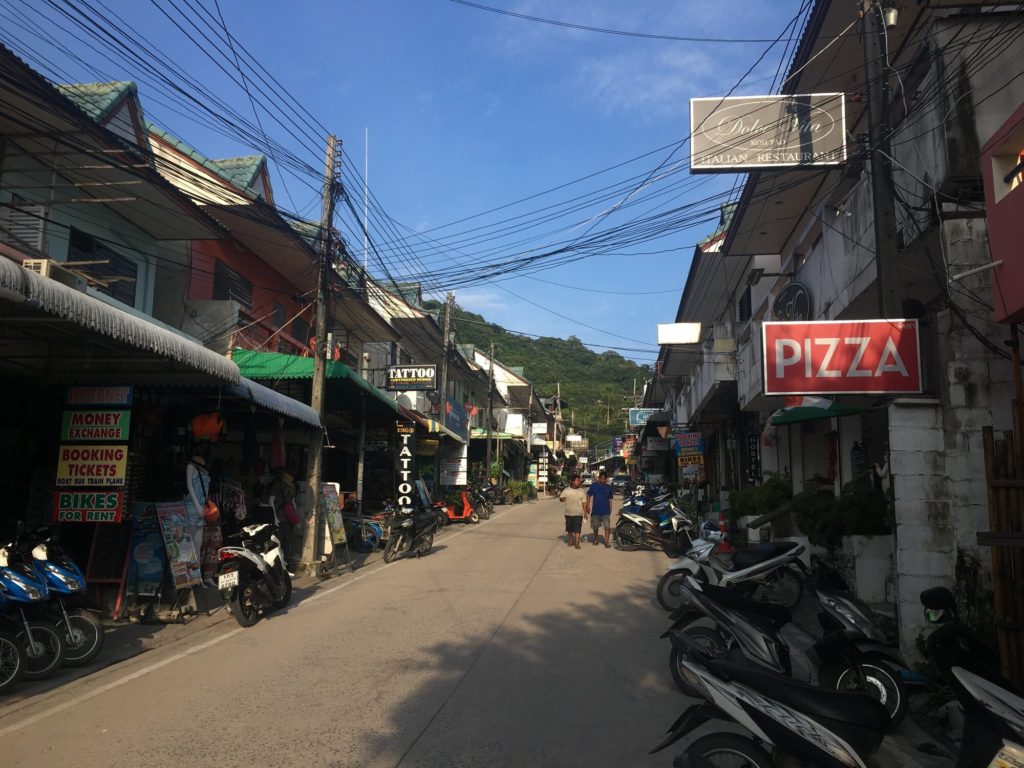 View of the street in central town.
View of the street in central town.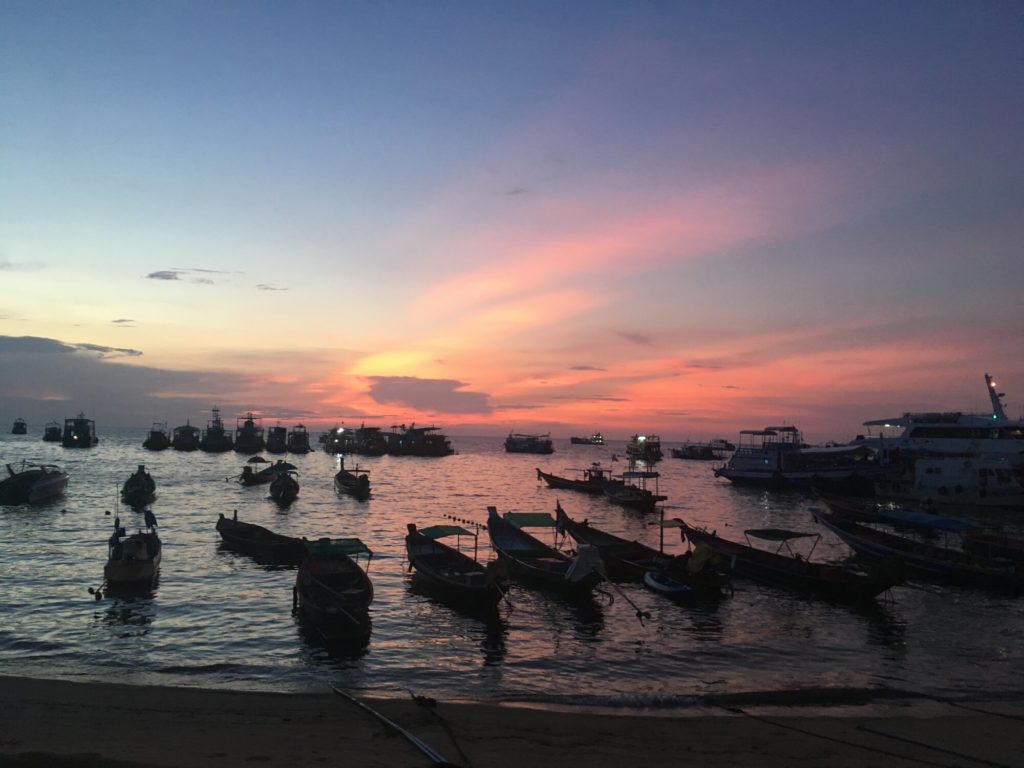 Sunset vibes nearby the arrival pier in Ko Tao.
Sunset vibes nearby the arrival pier in Ko Tao. Ladyboy performance in a bar in Ko Tao.
Ladyboy performance in a bar in Ko Tao.